- Yachting World
- Digital Edition


Sonar and sounders: 4 new models that are good for more than just fishing
- April 22, 2020
Developments in technology are now allowing us to see the shape and structure of the seabed, including vegetation, in increasingly clear detail. Rupert Holmes reports

Sonar has potential to help offshore racers like IMOCA 60s avoid submerged obstructions. Photo: Vincent Curutchet
Sonar and forward-looking depth sounders are often seen as the preserve of those whose primary interest is fishing. However, a huge amount of effort has been invested in these products over the past few years and the latest models can be powerful tools for both cruising and racing yachts . They offer sufficient clarity, for instance, to be able to pick out areas of seagrass and patches of sand in an anchorage.
Much of this improvement is thanks to the availability of CHIRP transducers that, unlike a traditional sonar, can distinguish between multiple targets through scanning using a signal of varying frequency. This enables them to show individual fish, rather than just indicate a shoal, to resolve vegetation growing on the seabed, and distinguish between a sandy/muddy shoreline and a rocky one.
For those of us who spend large periods of time in the Mediterranean during autumn months , when overcast skies or dark evenings can mean anchoring when it’s not possible to see the seabed, this could be a significant boon. As well as the obvious safety advantage, and convenience of being able to find sand at the first attempt, there’s also a benefit in avoiding damage to environmentally important seagrass beds.
Article continues below…
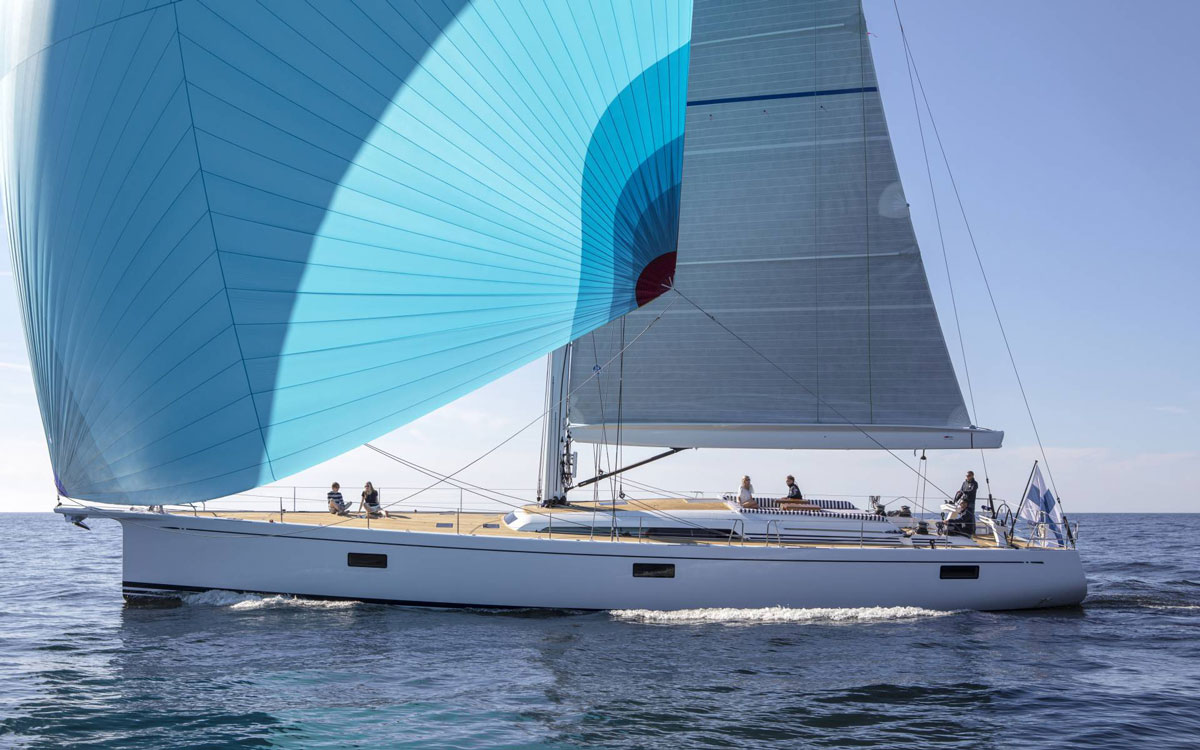
Forward-facing sonar: Everything you need to know
Yachting is usually pretty fast to embrace useful new technology, particularly if it helps win a race or if it…

Can augmented reality really give us a vision of the future of sailing?
Google’s mission statement is ‘to organise the world’s information.’ This almost impossibly ambitious declaration of intent underpins the technology giant’s…
On yachts, we’re most interested in what lies roughly ahead of the boat, unlike fishing where a good picture of what’s directly underneath or to the side is often more important. This means not all transducers developed for the fishing market will work well for our purposes, but we’ve listed a selection here that could be useful.
Even so it’s important to recognise that forward-looking sonar doesn’t replace existing data sources such as depth sounder, charts and visual references. Instead it provides additional data to help make more informed decisions. However, short ranges of typically 30m-90m mean this is a tool for use in confined waters in which the navigator is focussed on the task and not distracted at a critical moment.
As with radar, a degree of skill and knowledge is also required to set the system up and to correctly interpret the picture.
On the racecourse
Short tacking along a shoreline to gain relief from a foul tide is a key element of racing in many tidal areas. However, there’s an ever-present risk of grounding , which has been implicated in the subsequent loss of keels of several yachts, sometimes with devastating consequences. Anything that can help reduce that risk is therefore clearly advantageous.

A B&G ForwardScan image from Newtown Creek on the Isle of Wight
B&G ForwardScan
Professional navigator Mike Broughton specified B&G’s ForwardScan sonar for a new race-spec Swan 78 he sails as navigator. The system, which has a 180kHz transducer, scans the seabed over a 15° arc up to 90m ahead of the vessel, though gently shelving mud may bring the viable range in shallow water down to as little as 25m.
As well as showing a graph of the depth ahead of the boat, the ForwardScan data can also be superimposed on a chart, with shading to indicate safe, warning and critical depths. ForwardScan uses a removable slimline transducer that extends 31mm below the hull.
Writing in Yachting World , Broughton said: “I have used ForwardScan to great effect short tacking against a strong tidal stream in the Solent, gaining the confidence to tack back to the shore before our competitors helped make significant gains. Confidence that you are clear for just another boat length as you approach the shore can be gold dust information and allow your boat to achieve a clear lane of clean wind.”

The company therefore also offers a wider range of products, including a StructureScan transducer, which are geared towards fishing markets and show more detail of the seabed.
Price guide
ForwardScan transducer: £731 ForwardScan fairing block: £41 B&G Sonar Hub or StructureScan 3D Module: £628 StructureScan through-hull transducer: £649

EchoPilot’s long range FLS 3D system updates the seabed image every second
Long-established British brand Echopilot was one of the forerunners in this market and has been owned by the Danish Daniamant group since 2017. Echopilot’s range is optimised to show as much seabed detail as possible, rather than focussing primarily on displaying fish. It updates with very low latency and can be used at speeds of up to 20 knots.
The FLS 2D system has 30° beam width and maximum forward range of 200m, or ten times the depth in shallower water. The 7in screen uses different colours to represent different types of seabed structure, with hard materials such as rock showing as red and softer echoes from sand and mud showing as blue.
A more powerful FLS 3D model has twin retractable 200kHz transducers that give a 60° beam width. The range extends to 20 times the water depth, so around 200m in a 10m depth. Echopilot claims it can detect rocks at up to a distance of 500m.
Both models are also available in a black box format that will connect to any display with HDMI or VGA video input. In this case settings are controlled by a separate keypad that can be positioned next to the display.
FLS 2D with standard transducer and 7in display: £1,000 Echopilot FLS 3D with Dual Pro Transducers: £9,000

Garmin’s Panoptix LiveScope can differentiate between fish, seagrass and patches of sand
Garmin Panoptix
Many fishfinders show only the area below the boat or at the sides, but Garmin’s Panoptix products offer features that can be of use on cruising yachts. This range is available with through-hull transducers intended for fitting to yachts and has forward-looking functionality.
The FrontVü mode displays the seabed ahead of the boat at a range of up to 90m although, in common with other models, this reduces to eight to ten times the depth of water in very shallow water. The scanner has a 20° beam width and provides a clear picture at boat speeds of up to 8 knots.
The LiveVü Forward function allows you to see fish and the structure of the seabed at a reduced range of up to 30m. Both options are offered with the PS51-TH transducer at a cost of £1,360. This unit is a similar size to that of the B&G ForwardScan transducer.
Garmin’s top of the line Panoptix model, which has received rave reviews in the fishing community, is the LiveScope. This gives real-time scanning both forward and around the boat, with enough detail to see the difference between seagrass and patches of sand at a maximum range of 60m from the boat. On the downside, the LVS32 transducer is much larger and heavier.
PS51-TH transducer £1,360 Panoptix LiveScope with through-hull mounted transducer £1,870
While the ranges of recreational sonar units are clearly limited, they are a whole lot better than conventional depth sounders that have no ability to look ahead. Larger and more powerful transducers can provide more range at a frequency that allows a great deal of detail to be shown, but these may not be convenient to mount on a yacht and costs are significantly higher.

Race teams are interested in Far Sounder Argos 350 development
Far Sounder
Rhode Island-based Far Sounder produces a range of forward-looking sonar for large vessels with ranges of up to 1,000m at operational speeds of up to 25 knots. The company’s latest model has a smaller transducer with a 350m detection range that’s suitable for craft of 18-40m length.
The sonar map can be overlaid on CMAP professional S56/63 series charts in a similar fashion to the way we’re accustomed to overlaying radar on a chart. The downside, however, is that the transducer is still large for a sailing yacht – it measures 160mm x 200mm (6.4in x 8in) and needs to be at least 1m below the surface.
Could this system be used by racing yachts such as IMOCA 60s to give advanced warning of a potential collision with whales or shipping containers ? CEO Cheryl Zimmerman says the standard product could certainly do this for targets that are a couple of metres below the water.
She told me Far Sounder has been approached by race teams to “discuss some of the issues they are experiencing” and is “very excited” about the prospect of developing custom products with alarms to alert solo sailors.
Argos 350: US$55,000
Sonar performance
With sonar there’s always a conflict between range and detail. A low-frequency sonar of around 80kHz will be able to reach greater depths, but without a great deal of detail. Conversely, a higher frequency unit, operating at around 200kHz, will reveal more detail, but at the expense of range. Larger and more powerful transducers can provide more range at a higher frequency, but these may not be easy to mount on a yacht and become expensive.
Accuracy can be affected by factors including location of the transducer and water conditions. The strongest echoes are from hard seabeds such as rock and coral, whereas gently shelving sand or mud will only be seen at closer ranges and even then may not be as distinct.

Black box hubs can generate data for use on compatible chartplotter screens
Compatibility
We’ve come to expect much of the basic functionality of instrument systems and sensors to be compatible across displays offered by different manufacturers. However, this is by no means automatically the case for sonar, where there can even be gaps in compatibility even within a single manufacturer’s product range. In addition, many MFDs lack the software needed to process sonar data, so an intermediate sonar hub may be needed.
Before buying sonar equipment it’s important to understand exactly what the chosen technology will do and the equipment it will interface with. The technology is certainly not for everyone and, with a few notable exceptions such as short tacking along a shoreline, units for the recreational market are next to useless at typical passagemaking speeds due to the short range.
However, there are plenty of use cases in close-quarters slow-speed scenarios, including exploring poorly charted anchorages. This is just as relevant for cruising Greenland or Patagonia as for finding the deepest water over the bars of rivers such as the Rio Dulce in Guatemala or Senegal’s Sine Saloum. In these situations sonar could prove a powerful additional tool, particularly if time is spent on learning how to get the best from the system.
First published in the March 2020 edition of Yachting World.
Practical Boat Owner
- Digital edition

Best forward-looking sonar: 5 units tested
- Ben Meakins
- May 10, 2016
How effective is forward-looking sonar at flagging up shoals and obstacles on the seabed? David Pugh compares the findings from five devices

Would you like to be able to spot an obstacle before your boat hits it? Of course you would, and so would every other sailor in the world. Looking ahead is the Achilles’ heel of the conventional echo sounder , which can only tell you the depth of the water in which you are already floating. If you wait until the sounder reads zero, it’s too late. That’s where forward-looking sonar comes in.
Admittedly, the conventional sounder can tell you a lot, and in recent years plotters have started to display not only current depth, but also history via their fishfinder screens. It’s a fair bet that if the depth is steadily decreasing, the time will soon come to change course. But this approach only works in gently shoaling water: abrupt changes in depth could spell disaster.
Looking ahead
The traditional approach to looking ahead has always been to do so before you take your boat anywhere near a potential hazard. We do it all the time, using the chart and calling it passage planning. A good survey and a precise position has been the key to keeping boats off the rocks for years, but there are times when this isn’t an option. Some places are still poorly charted, and even in our well-surveyed UK waters there are moving shoals which defy the efforts of hydrographers and harbour buoyage.
One option is to jump in the dinghy with a leadline or sounding pole and carry our your own mini-survey beforehand. But if you’re nosing up a river and simply want an early warning of a shoal, or are nervous of finding the right spot to anchor in a rocky loch, wouldn’t it be nice if your echo sounder gave the depth ahead of the boat?
Best forward-looking sonar: What’s available ?
For years, the undisputed king of the niche market of forward-looking sonar has been Ringwood-based Echopilot. Various iterations of their forward-looking technology have sold all over the world, and their only historical competitor disappeared some time ago.
Now, however, things have changed. Navico, the parent company to Simrad, B&G and Lowrance, recently announced a forward sonar transducer and updated software for their SonarHub module and plotters, while Garmin have developed a version of their high-definition Panoptix fishfinder designed to look ahead. While Echopilot and Navico are in direct competition, the Garmin product is a little different, aiming to find fish at a limited range ahead of the transducer – they provide a version of the transducer designed to fit a trolling motor shaft to facilitate scanning around the boat. However, it does provide imagery of topographical features too, and hence could be of use in spotting hazards.
We gathered together five contenders: three from Echopilot and one each from Garmin and B&G, fitted them to an old 3.6m (12ft) dinghy and put them through their paces in Poole Harbour. We tried looking at a range of features, including solid piling, bridge piers, gently shelving beaches and mooring chains, as well as using the units to find our way down a narrow channel of soft mud.
Echopilot FLS 2D

A channel buoy’s chain, picked up at around 12m
The only unit tested with a dedicated display, the FLS 2D comes with a choice of transducers. The standard transducer is sold as suitable for smaller boats, has plastic encapsulation and uses a 45mm through-hull fitting. The ‘Professional’ transducer is a much heavier unit of bronze, costing an extra £170 and using a 60mm through-hull. Installation is simple – fit the transducer, plug it and the power cable into the back of the display and you’re done.
To display the information, Echopilot uses a screen showing a cross-section of the water ahead of the boat. On this are plotted the echoes received by the transducer, using colours graded from blue to red to show the strength of the echo (red being the stronger). By default, the unit is set to choose a range automatically, but the user can override this.
The user interface is not immediately intuitive, but once the unit is set up the most you are likely to need is to change the range, achieved simply enough using the ‘Up’ and ‘Down’ softkeys. There is an auto setting, which changes the range based on the depth, but in difficult conditions the manual setting is helpful.
On the water, we initially struggled to make sense of the display, but with practice the manner in which the data is shown and colour-coded to indicate the strength of the echo allows a significant level of interpretation from the user. For example, a mooring chain or stake will give a vertical line of strong, red returns with some weaker echoes either side. The red shows that you should pay attention despite there being relatively few data points. Soft mud, on the other hand, gives a scattering of weaker echoes as the sounder struggles to find the bottom, so the truth is likely to be a middle value.
We tested the range of the sounder by looking at a solid concrete wall. The wall was clearly visible at ranges just over 100m, which was the width of the channel in which we were working. Smaller targets such as mooring chains were harder to acquire, with the range typically less than 10m before we could say with confidence that the object was there. At this kind of range the narrow width of the transducer beam becomes obvious, so the bow needs to be held steadily on the target.

The seabed slopes down to the right, ending at a solid wall at 75m
In soft, shallow mud, the FLS 2D would become confused when in auto mode owing to some echoes being apparently very deep, requiring the range setting manually. This removed most of the spurious results and made the display useful once more, although the depths it recorded were clearly far too high.
Switching to the professional transducer resulted in a cleaner signal, but surprisingly a shorter range at just over 80m. The beam also appeared narrower, so on a small boat where the heading is not necessarily constant, the standard transducer is perhaps a better choice.
RRP: £1,179 / $1,569 (inc. standard transducer)
Buy it now on eBay (UK)
Buy it now on eBay (US)
With each product is a ‘Buy it now’ link. If you click on this then we may receive a small amount of money from the retailer when you purchase the item. This doesn’t affect the amount you pay.
Echopilot fls platinum engine.

Solid piling, visible at 90m on our range test
The FLS Platinum Engine comprises three components: the transducer, a sturdy bronze unit with a 60mm through-hull fitting, a transducer interface box and a video interface box. The video interface can output composite or S-video, suitable for viewing on a third-party plotter or external screen. Control is via an external keypad plugged into the video interface.
In operation, the Platinum engine is similar to the FLS 2D, with the data displayed in the same way. We used the composite video output, but it would pay to use S-video if possible to take advantage of its improved resolution.

Rocks at 32m. The scattering from the irregular shapes makes the return weaker, but there is clearly an obstacle
The transducer is identical in appearance to the Professional transducer for the FLS 2D so, perhaps unsurprisingly, our results were similar. Our range test picked up the wall at about 90m and, like the FLS 2D, it tended to show spurious depths in soft, shallow channels. It was, however, quicker to get back to normal once the boat moved out of the difficult area. We found it harder to pick up mooring chains and narrow objects with the Platinum engine, perhaps due to a narrower beamwidth from the transducer and the tendency of a small boat to yaw. It detected the multi-faceted rocks of some sea defences, albeit with a fairly scattered plot.
RRP: £1,000 (inc. transducer)
Buy it now on echopilot.com
Echopilot FLS 3D

A channel mark’s chain, appearing 30m away as a peak in the midst of deeper water
Echopilot’s flagship model, the FLS 3D, takes a different approach to the 2D products. By using two hefty 75mm through-hull units, each of which contains two angled transducers, the sounder can combine the data to display a 60° sector ahead of the boat.
The amount of data from four transducers would produce a confusing mess if displayed with no further processing, so Echopilot have included a computer in the system to render a surface which best fits the data, and output the video. As a result the system comprises three stages: the transducers, the transducer interface and the computer. From the computer, you can output VGA or DVI to a screen, or go through a converter for composite or S-video.
Like the 2D models, the picture is colour-coded to aid spotting the difference between shallow and deep water. This makes for a very intuitive picture, but a user needs to bear in mind that the surface displayed is similar to that which would be made if you were to drop a blanket over the seabed –spikes are smoothed into curved peaks and vertical walls become steep slopes.
On the water, the display is very easy to read, and we found it good for seeing continuous features such as channel edges. Our range test yielded a shorter range than the 2D sounders, with the wall ahead convincingly visible from about 35m. I suspect this may be due to there being insufficient data points for rendering until you are closer to the obstacle, while the 2D products show the data for the user to interpret.

Approaching a steep wall at about 15m. Water appears to exist beyond the wall
Another oddity when approaching the wall was that the sounder showed a depth of water continuing beyond it – not a problem, but something that takes getting used to.
The FLS 3D is primarily sold to larger boats, so our test in a narrow, shallow channel was perhaps unfair. Nevertheless, variations in depth consistent with the channel edge were visible, and had a shorter range than 40m been available would have been clearer. Heading down the edge of a deepwater channel, the edge was clearly defined and navigation mark chains appeared as steep peaks, suggesting that this would be a valuable tool for nosing up a river.
RRP: £9,550 / $13,000 (inc. 2 transducers)
B&G ForwardScan sonar

With simple structures like the wall, the danger is immediately obvious
As might be expected from a plotter manufacturer, this unit is designed to work with B&G’s own displays, removing the video interface element common to the Echopilot black box products. However, you will still need an interface box (SonarHub) to connect the transducer to the plotter. Once done, and with your software updated to suit, a new option will appear on the menu: ForwardScan. By default, this shows a shaded area designed to represent the seabed ahead of the boat – brown in our pictures, but you can change the colour pallette. Essentially, this is a line of best fit – the data points can be overlaid if you wish, either both above and below the line, or just above. These points are colour-coded in a similar fashion to the Echopilot plots.
ForwardScan in use
In its default state, just showing the line of best fit, the screen is easy and intuitive to read. On our range test, the sounder showed the steep wall at a maximum range of 65m. This is significantly shorter than the Echopilot, but turning on the data points showed evidence of the wall at around 80m – the software clearly needs more data points than the human eye to confidently predict the seabed.

Mooring chains are shown by the data, but ignored by the line
In shallow, muddy water the best-fit line lost its lock on the bottom, but turning on the data points again made the display useful, with the distribution giving an indication of whether the water was getting deeper or shallower ahead of the boat.
Because ForwardScan is integrated into an existing navigation package, it already has reliable depth information from a separate transducer, so is more resilient to scaling problems based on false readings than the Echopilot units. It also proved useful to be able to display the data alongside the chart, especially when moving along a channel edge.

In soft mud, the line of best fit fails, but data points still show trends
RRP: Transducer £540, SonarHub £470 / $1,079
Buy it now from eBay (UK)
Buy it now from eBay (US)
Garmin Panoptix Forward

RealVü scans from left to right to build a realistic image of the seabed. Here’s a wall at 14m
A single transducer, which plugs directly into the back of a compatible Garmin plotter using Ethernet, Garmin’s Panoptix Forward sonar product is more intended as a fishfinder for looking around your boat than as a device for spotting obstacles while under way.
The transducer comes with two mounts – one for the transom, the other to fit it to the shaft of a trolling motor, allowing it to rotate. The transducer itself is large (approx 170mm x 90mm) and dips below the transom at an angle of around 45°, so it is unsuitable for sailing craft in its current incarnation owing to drag. It also loses picture at speed, presumably owing to disturbed water around the transducer, while the Echopilot and B&G products can be successfully used on the move.
The plotter offers two forward views: LiveVü and RealVü 3D. LiveVü will look familiar to fishfinder users, with the classic blue screen and smeared lines, coloured to show the strength of the echo. RealVü scans a 60° arc ahead of the boat to build a picture of the seabed ahead, similar to the Echopilot 3D. However, unlike the Echopilot, which shows a picture all the time, RealVü scans, building the image from left to right.

A piece of rail marking a channel edge, viewed at 8m
The Vü ahead
Using LiveVü, the range is limited compared with the other products, the best we achieved on the solid wall being just under 40m. At close range, however, the system offers significantly more detail than any of the other products, suggesting that it operates at a higher frequency, trading range for detail.
This conclusion was borne out by a test we tried in the shallow waters of Poole’s Holes Bay, looking at a channel mark made from a piece of old railway rail. Both the Echopilot and Navico products showed this as a collection of a few echoes, while the Garmin showed a clear vertical obstacle at about 8m.

Shoaling depths are clearly shown
In RealVü mode, the range is reduced compared with LiveVü by the rendering facility – as you move away from a feature, the image begins to fragment as the quality of the data reduces. It’s also a bit slow, taking several seconds to build each picture before starting again. However, the image produced is realistic and detailed. Data points not used in the rendering are overlaid to give an indication whether any features have been ignored.
If RealVü could work faster and under way, it would make a great tool for exploring narrow channels.
RRP: £1,299 / $1,499 (transducer only)
PBO Verdict
If you’re looking to avoid collision, rather than carry out a close-range survey of the seabed, we have to discount the Garmin from the running. Its limited range and intolerance to turbulence make it unsuitable for use at anything more than trolling speeds, but if Garmin can produce a through-hull transducer that deals with these problems, its impressive level of detail makes it a product to keep an eye on in the future.
The Echopilot FLS 3D is best suited to larger boats, not least because of its size and cost. We also found it worked best in deeper water, where the ability to see for a significant angle either side of the bow proved extremely beneficial, picking up the edge of the shipping channel in Poole with a high level of detail.
For smaller boats, however, any of the 2D products would prove a useful addition to your instrumentation. ForwardScan is the most intuitive thanks to its line of best fit and is the obvious choice if you already have B&G, Simrad or Lowrance gear on board, but with practice I found that I preferred to see the raw data and draw my own conclusions – the approach used by Echopilot. In this mode, the Echopilot pictures were cleaner, with fewer spurious echoes either side of the true data. As the long-standing market leader in forward sonar, it’s perhaps to be expected that their filtering of the data might be better, and this seems to be the case.
Which of the Echopilot products you choose depends on personal considerations. The FLS 2D offers best value for money, and we found the standard, cheaper transducer to be perfectly adequate. The Professional transducer adds detail but is bulkier and heavier, with a greater protrusion below the hull. For a little extra cost, if you already have a plotter the Platinum Engine offered best performance across a range of conditions.
Whatever you choose, it’s important to remember that they aren’t infallible, and are affected strongly by the surface at which they are looking. All of them worked well in shoaling water, the plots clearly indicating reducing depth from a shelving beach. Soft mud and shallow water confused them all to a greater or lesser extent, as is only to be expected when you fire a sonar beam obliquely into a soft medium. Broken rock (used as sea defences for a marina) scattered the beams, confusing attempts at 3D rendering by the Garmin RealVü or Echopilot 3D, but visible as scattered dots on the other products. Plane surfaces or protrusions from the seabed worked better.
When I set up the test, Mike Phillips of Echopilot warned ‘it’s a bit like using radar. You have to get used to it’. He’s right, and like radar, forward sonar needs interpretation. Software can help, but a practised operator will get more from it than a novice. It doesn’t replace a chart or a good position, but teamed up with other information might just keep you off the rocks or putty, or help avoid that uncharted underwater obstruction.

EchoPilot FLS 3D Featured In The Annual SuperYacht Technology Summer Blueprint
EchoPilot is proud to be featured in the annual SuperYacht Technology Summer Blueprint. The annual Blueprint is selected for only the best technologies for the SuperYacht Market and is featured worldwide.

EchoPilot Featured in SuperYacht Technologies
Click to read more.

EchoPilot Featured in Boating Business


- Subscribe Now
- Digital Editions

Best depth sounder models from handheld to top of the range
Depth sounders are pretty crucial bits of kit for all of us. If you want to have an idea of how much water is beneath your keel then you will need a depth sounder of some sort - unless you want to go old school and send someone to the bow with a longline and weight...
The trend in recent years is towards boats running the vast majority of boat data through a chartplotter or Multi Function Display (MFD) but most of the best depth sounder models still come with a separate specific LCD display screen. The display itself is reasonably simple and the key concern is ease of use as well as brightness of the display and backlight functions. However, to get a depth reading you will need to fit a transducer into your boat.
When fitting a stand-alone depth sounder it sometimes comes with an in-hull transducer. These are mounted in a plastic tube and is fitted vertically to the inside of the hull. The tube contains some oil beneath the transducer itself which allows good sound transmission through the hull. If you fit a dual speed/depth transducer, or another type of through hull transducer, it will need to be mounted through a 50mm diameter hole in the hull.
Depth transducers transmit sound pulses or ‘pings’ that bounce back on hitting the seabed. The time the ping takes to travel down and return is a measure of the distance to the seabed. The only difference between so-called ‘analogue’ and ‘digital’ transducers is that, in the latter, the signal is sent out as data over a NMEA interface.
Best depth sounders available right now
Raymarine i50 depth sounder.
Best depth sounder for usability
The Raymarine i50 instruments are designed to complement Raymarine’s latest generation multifunction displays. The i50 comes in a number of different options. The i50 depth offers only a depth readout, while the i50 Tridata display offers speed and depth, while a measure log tracks distance sailed.
Recommended videos for you
The screen features excellent viewing angles for both day and night conditions and simple, push-button controls make i50 instruments easy to see and use. This display offers low power consumption, has a good red lighting for visibility in the dark and is easy to install. This has fast become one of the most popular depth sounder display units on the market.
In terms of the transducers on offer from Raymarine there are several to choose from. Raymarine does offer an in hull transducer (the P79) and a range of options for through hull depth alone the best of the bunch if you are looking for standalone depth would be the P19. These would be the transducers most likely to go with the i50 depth display as a standalone depth sounder.
To fully take advantage of the display, you would want to consider a depth and speed transducer sold alongside the display as a kit. The D800 is a Smart multisensor by Airmar – supplier of the majority of depth transducers on the market – that offers depth, speed, and temperature functions in one thru-hull fitting. Digital signal processing inside the housing provides depth, speed, and temperature data to a chartplotter, radar screen, or digital display such as the i50.
Reasons to buy: Excellent viewing angles, simple controls, easy to install
Reasons to avoid: Requires depth and speed transducers (sold separately) to fully take advantage
Buy Raymarine i50 Depth kit on Amazon
Buy Raymarine i50 depth kit on eBay
Buy Raymarine i50 Tridata kit on Amazon
Buy Raymarine i50 Tridata kit on eBay
Note: We may earn a commission when you buy through links on our site, at no extra cost to you. This doesn’t affect our editorial independence.
Nasa marine clipper.
Best low cost depth sounder
Nasa has built a solid reputation for building marine electronics that work well, are affordable and simple to use. As such, NASA’s Clipper range is well known by now and trusted and is a particular favourite of small-to-medium-size boat owners. Whilst they might not be the flashiest instruments, they do a pretty good job and are available as stand-alone analogue devices for a very reasonable price.
The Clipper Depth looks somewhat dated, but the digits are very large and easy to read from a distance, which is more important than having a fancy trim. The supplied in hull depth transducer wires directly into the display head, offering a no-nonsense, easy to fit depth option without many bells and whistles.
Nasa Marine also provide a Clipper Duet option which comes with a through-hull transducer, enabling speed and depth measurements. Installation is slightly more complicated due to the through-hull transducer, but this is a very cheap way to get speed and depth onboard.
Reasons to buy: Great price, great reputation, simple to use
Reasons to avoid: Dated design
Buy Nasa Marine Clipper Depth from eBay
Buy Nasa Marine Clipper Duet from eBay
B&G Triton 2
Best top-end depth sounder
B&Gs Triton² provides sailors with a clear view of key instrument data such as speed, depth, wind and heading along with a dedicated SailSteer technology page. For the majority of these functions you will require further B&G kit, but given their position in the market as the go-to instrument supplier for serious racers it is hardly supposing they would expect users to be considering more than simply depth alone.
Combined with a Triton² Pilot Keypad, the display can also serve as a complete autopilot control system. The display is a low profile design, and offers an efficient LCD screen and easy installation makes it the perfect choice on cruising sailboats, or integrated within a full navigation system on cruising and racing boats.
You can buy Triton² display units with either a depth/speed though hull transducer or to take full advantage of the unit’s abilities with a depth/speed through-hull transducer and a wired wind pack all of which will allow the use of B&Gs SailSteer technology. The whole lot can also be purchased as a wireless package.
Reasons to buy: Clearly displays key instrument data, easy installation
Reasons to avoid: Relies a lot on further B&G kit at further expense
Buy B&G Triton² display from B&G
Buy B&G Triton² display from West Marine
Garmin GNX 20
Best depth sounder for customisation
The easy-to-read GNX 20 marine instrument display from Garmin displays black digits on a white background, or background in a variety of colours. It is able to display depth, speed, wind and 50-plus marine and boat parameters. Its glass-bonded display with anti-glare lens coating provides good daytime and nighttime readability with high-contrast digits scalable up to 36 mm.
Fully customisable user profiles allow you to choose from five available display configurations for sailboat or powerboat user-profiles: single, dual and triple function, plus gauge and graph mode to display wind, depth and speed data, or customise the pages to display the marine and boat data that is most important to you.
It’s NMEA2000 compatible and, as with many of the depth sounders in this list, is designed to work alongside a main MFD unit. To make the most of the functionality of the GNX 20 you will want a full functioning through-hull transducer, such as the DST 800 by Airmar.
Reasons to buy: Fully customisable profiles, easy-to-read
Reasons to avoid: To get full functionality you’ll require a through-hull transducer
Buy Garmin GNX 20 unit on Amazon
Buy Garmin GNX 20 unit on eBay
Plastimo Echotest depth sounder
Best for depth measurement without installing electronics
This handheld device requires no installation at all to your boat and is very simple to operate. It is totally waterproof and gives readings to a maximum depth of 80 metres. The Echotest has a Large LCD Display with LED back light, making it useable at night.
To use you need to dip the head into the water to see how much water is beneath you. It runs off a 9V drycell battery. This is certainly not the most accurate or best option if you have a larger boat but for those planning on a bit of dinghy cruising, or without power onboard it could offer a decent option.
Reasons to buy: Handheld so requires no operation
Reasons to avoid: Operation not the most accurate, not great for larger boats and requires a battery
Buy Plastimo Echotest depth sounder from Tradeinn.com
Best sonar systems on the market
If you want to go one step further in your understanding of what lies beneath, you may want to consider a forward-looking sonar unit . The latest models of marine sonars can be powerful tools for both cruising and racing yachts. Such has been the improvement that you can now get sufficient clarity to pick out areas of seagrass and patches of sand in an anchorage.
Broadly speaking, the improvement is thanks to the availability of CHIRP transducers that, unlike a traditional sonar, can distinguish between multiple targets through scanning using a signal of varying frequency. This enables them to show individual fish, rather than just indicate a shoal, to resolve vegetation growing on the seabed, and distinguish between a sandy/muddy shoreline and a rocky one.
B&G ForwardScan
B&G’s ForwardScan sonar has a 180kHz transducer, and can scan the seabed over a 15° arc up to 90m forward, but this can, and will, reduce depending on bottom conditions and water depth.
As well as showing a graph of the depth ahead of the boat, the ForwardScan data can also be superimposed on a chart, with shading to indicate safe, warning and critical depths, which makes it much more intuitive to use. ForwardScan uses a removable slimline transducer that extends 31mm below the hull.
The company offers a selection of models in the range, suitable for different purposes including a StructureScan transducer, which is geared towards fishing markets and to show more detail of the seabed.
Reasons to buy: Shows a full graph and can be superimposed on a char with shading
Reasons to avoid: Premium pricing, aimed at fishing markets
Buy B&G ForwardScan transducer from eBay
Echopilot FLS 3D
Echopilot’s range is optimised to show as much detail of the seabed as possible, rather than focussing primarily on displaying fish. It updates quickly and so, the manufacturer claims, can be used at speeds of up to 20 knots. This represents a significant boosts to old systems, which were only really usable at very low speeds or sub-5 knots.
A more powerful FLS 3D model has twin retractable 200kHz transducers that give a 60° beam width. The range extends to 20 times depth, so around 200m in 10m of water. Echopilot claims it can detect rocks at up to a distance of 500m. This more powerful offering does offer much more in terms of data readability. It does offer a three-dimensional picture of the ground ahead, and better accuracy from distance, but the price is greatly increased.
Reasons to buy: Can be used at speeds of 20 knots, the powerful 3D model gives around 200m coverage in 10m depths
Reasons to avoid: Very premium price
Buy Echopilot FLS 3D from MarineComponents
Garmin Panoptix
Many fishfinders, including many of Garmin’s own, show only the area below the boat or at the sides, but Garmin’s Panoptix products offers through-hull transducers intended for fitting to yachts and has forward-looking functionality.
The FrontVü mode displays the seabed ahead of the boat in impressive detail but as with the similarly detailed B&G offering, only at a range of up to 90m, reducing to eight to ten times the depth of water in very shallow water. The scanner has a 20° beam width and provides a clear picture at boat speeds of up to 8 knots.
The LiveVü Forward function allows you to see fish and the structure of the seabed at a reduced range of up to 30m. Both options are offered with the PS51-TH transducer at a cost of £1,360. This unit is a similar size to that of the B&G ForwardScan transducer.
Reasons to buy: Through-hull transducers with forward-looking functionality, LiveVii allows you to see fish and seabed structure at range of up to 30m
Reasons to avoid: Premium price
Buy Garmin Pantopix Livescope system from eBay
Didn’t find what you’re looking for? Head to Amazon’s dedicated boating page for more marine products.
Best Prime day deals on Pressure washers
Best prime day cooler and 12v portable refrigerator deals, best pressure washers for boats: 8 top quality products for a thorough clean-down, latest videos, watch: parker sorrento sea trial: 50-knot cruiser with a killer aft cabin, watch: virtue v10 sea trial: €272k weekender, how to mark your anchor chain: 6 top tips from our expert, watch: galeon 560 fly sea trial – the best galeon flybridge you can buy.

What Is An Echo Sounder And How Does It Work?
Grounding is one of many possible accidents that a vessel encounters. This happens when the bottom of the ship touches the seabed. The damage can be minor or it can lead to a severe oil spill.
To avoid this, bridge officers can check the paper charts or ECDIS (for paperless vessels) for the depth and sounding of water. While the vessel is in port, the ship’s crew may use a sounding lead to measure the depth of water.
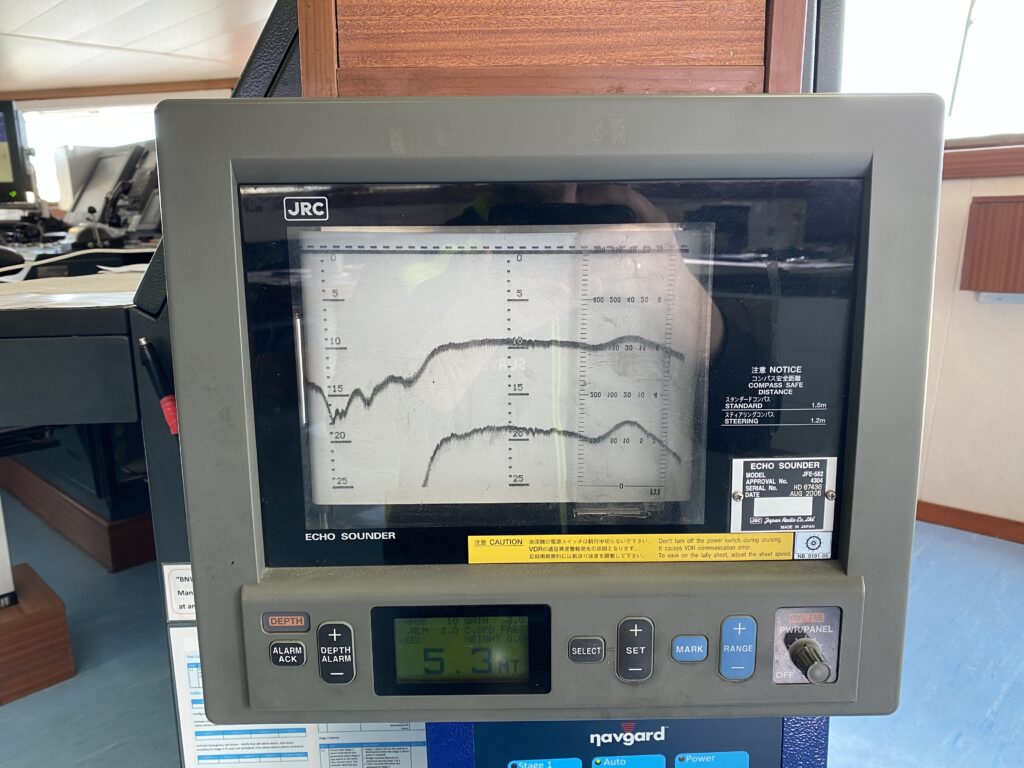
What Is Echo Sounder?
To get accurate information, an echo sounder is used by officers on watch. It measures the depth of water and more importantly, the under-keel clearance.
The echo sounder transmits sounds from the bottom of the ship to the sea bed . The main components are the transmitter, transducer, receiver, and display unit. Transducers can either be electrostrictive or magnetostrictive.
How Does Echo Sounder Work?
Magnetostrictive transducers use iron, cobalt, and nickel. Nickel is widely used in the industry as it has the greatest change when placed in a magnetic field. Nickel contraction happens when an alternating current is applied. It uses a permanent magnet to compensate for the process. Magnetostriction is effective up to a few hundred kilohertz frequencies.
For electrostriction, the echo sounder uses different types of lead materials and works on compressive or tensional forces. These forces create a change of length or dimension in the material. It is effective up to 1 megahertz frequency.
The display unit can either be a paper recorder, video type, or digital info display.
The echo sounder uses the formula distance=speed x time / 2.
The transmitter creates an electrical pulse which then passes thru the transducer. The transducer which is located at the bottom of the ship converts it to sound waves. The sound waves may either hit the sea bed or anything in between.
For fishing vessels, it is used to find schools of fish underwater. These pulses hit the scales of the fish and reflect it back to the transducer which allows trawlers to find fishing grounds.
Once the transducer receives the back sound waves, it is converted back to current which is then reflected on a digital or video display and in some cases, burned in a paper recorder-type echo sounder.
Echo Sounder Types?
Echo sounders are classified into two types. These are the single-beam echo sounders(SBES) and the multi-beam echo sounder(MBES)
Single-beam echo sounders were initially developed around 80 years ago and were used instrumentally for primary oceanic discoveries and standardization. It is also known as a fathometer or depth sounder. It works on a single sound pulse in a single narrow beam and can only measure one point per echo.
Nowadays, SBES is used for depth measurements, sub-bottom observations, and seabed imaging.
Other SBES are defined by their beam angle and frequency of transmitted sound waves. Water depth capabilities of single-beam echo sounder range from less than one meter to full ocean depth.
The second type of echo sounder is the MBES or the multi-beam echo sounder. It emits a multidirectional beam to obtain information in the affected area. The sound waves received back by the transducers provide detailed information on the depth of water, the shape of the river, lake, and other underwater features.
This information is used by Geological survey companies to accurately generate high-resolution maps of harbors, berthing terminals, lake bottoms, and channels used for navigation.
What Is The Difference Between Echo Sounder And Sonar?
Though both the echo sounder and Sonar are quite both similar, they have some differences.
The echo sounder allows a ship to measure the depth of water and under keel clearance from only under the ship. The echo sounder uses a transducer that is mounted on a fixed position at the keel of the vessel.
The direction principle of an echo sounder is mainly vertical which uses single beams or multiple beams. It is mainly used by merchant ships , trawlers, tug boats, yachts, and similar vessels.
The sonar on the other hand gives a wider picture underwater since it utilizes an adjustable transducer which enables it to scan 360 degrees. It also works on a much stronger frequency and uses a transmitter and receiver which are capable of transmitting and detecting ultrasonic waves.
The sonar is mainly used by military vessels such as warships, submarines , and aircraft carriers.
How To Use Echo Sounder?
Before using the echo sounder, the officer of the watch checks that the equipment is working properly and has been set up. First, be familiar with the mode options of the echo sounder to avoid confusion and possible grounding is prevented.
The normal mode will be the navigation mode. In navigation mode, the echo sounder measures the depth of water from the transducer position to the seabed. At times, it is referred to as the under-keel clearance.
The DBS (draft below the surface) mode is the next available mode. This is the depth of water including the draft of the vessel. Simply add the known draft of the ship and the reading below the surface in navigation mode. There is a draft button to enter the ship’s draft as well.
The history and log data mode allow the officers to see previous readings of the ship as well as recorded data in the echo sounder.
How To Check Accuracy Of Echo Sounder?
Before an accurate reading of the echo sounder can be achieved, it must be set up properly. The initial setting can be done in two stages.
The moment of transmission must be set to the depth of transducers below the waterline.
Next, the speed of the echo sounder stylus is aligned with the sound velocity in seawater.
The most widely used method by industry experts to check echo sounders is the bar check. This is recommended for shallow waters up to depths of about 300 meters, at which a good clear echo can be obtained from the bar.
Though in shallow waters, it is quite difficult to check the accuracy of echo sounders. The weather must be fairly good, with good wind, smooth and calm sea, and tidal streams that are slack.
Since the transducer is very close to the seabed, it is difficult to know when the echo is actually received. The contour of the seabed, strong current, and drift can greatly affect the sound waves wherein readings can be doubtful.
Take note that errors in deep waters are much more compared to depths of 30 meters or less. The speed of sound in shallow water may be greater compared to the sound velocity in deep waters, hence the error will produce depths greater than the actual readings. This must be checked and confirmed to avoid miscalculations during berthing maneuvers or shifting of the vessel.
- Recent Posts
- The Role of Cargo Ships in Global Trade – August 22, 2024
- Report: Yang Ming’s YM Mobility Explosion at Ningbo-Zhoushan Port – August 9, 2024
- Understanding Drillships: Types, Key Features and Advancements – August 1, 2024
About the author
I worked as an officer in the deck department on various types of vessels, including oil and chemical tankers, LPG carriers, and even reefer and TSHD in the early years. Currently employed as Marine Surveyor carrying cargo, draft, bunker, and warranty survey.
Leave a Reply Cancel reply
Your email address will not be published. Required fields are marked *
Save my name, email, and website in this browser for the next time I comment.
Latest posts

The Quality Control Process in Marine Manufacturing
Companies in the marine manufacturing space must have tight and effective quality control processes. What steps should an effective quality control process include?

The Role of Cargo Ships in Global Trade
Contents show Volume of Goods Transported by Sea Key Global Trade Routes Economic Impact of Maritime Shipping Types of Cargo Commonly Transported Environmental Considerations Conclusion Cargo ships are the lifeline […]

What Are AGVs? Automation Becoming Increasingly Common in Seaports
What are AGVs? Automated guided vehicles can minimize the troubles of manual operations and enhance seaport operations.

- Consultation & Design
- Installation & Service
- Boating Tech Talk
- Case Studies
- Testimonials
- PYS Merchandise
- PYS Donation

Depth Sounder vs. Fishfinder vs. Sonar?
Technically speaking, a depth sounder uses a 50 KHz frequency broad beam (~35 degrees) to measure just the bottom depth. The lower frequency allows the sounder pulse to travel deeper per watt of power. A fishfinder transmits a higher-frequency narrow beam (6 to 22 degrees) in the 200 KHz range, which produces a higher resolution echo coming back to the boat. This high resolution echo allows the fishfinder to detect smaller targets, like fish, with less background noise but at a reduced depth. Sonar is a general term that covers all underwater sound imaging technologies, including both depth sounders and fishfinders.
In reality, you will find that these two terms are often confused, especially in marketing ads. In your case, the Garmin GPSMAP 720s can use a 200 KHz (or dual frequency 200/50 KHz) transducer, allowing you to find those fish lurking in the depths.
Related Products

GARMIN GT51M-TM Chirp, ClearVu, SideVu transom mount

RAYMARINE RV100 Transom-mount RV transducer
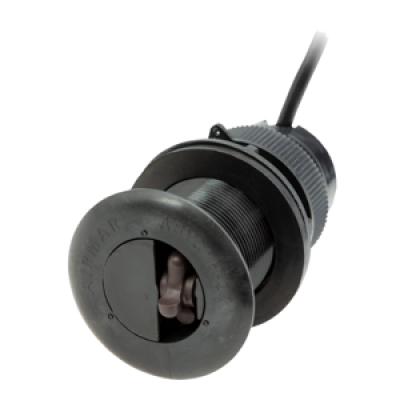
Navico DST-810 Transducer, thru-hull, NMEA 2000, depth, speed, temp
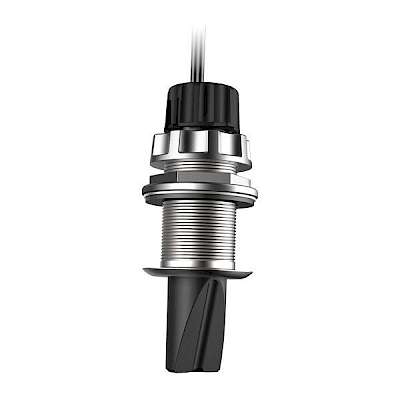
GARMIN PS51-TH Panoptix Forward Scan thru-hull

GARMIN GT23M-TH Chirp, ClearVu thru-hull

Raymarine DST-800 Transducer, thru-hull, analog, depth, speed, temp
Related content.

Boating Tech Talk VHF Interference from Transdcuer Cabling?

Videos Em-Trak B953 Class B AIS Transceiver Unboxing and Product Review

Boating Tech Talk Depth Sounder vs. Fishfinder vs. Sonar?

Videos Airmar DST810 Smart Transducer UnBoxing and Product Review

Videos Benefits of Navigation and Data Instruments on a Boat

Videos Raymarine Axiom 9+RV Multifunction Display - UnBoxing and Product Review

Videos Marine Depth Sounders

Videos Jeff's Recommendations for a Basic Navigation Package for your Boat

Videos Garmin 1222/1242 Touch vs. Non-Touch

Videos Choosing a Depth Sounder - Fish Finder, Side-View, Down-View, or Forward Scan?

Videos How To: Marine Electrical Seminar - Troubleshooting Your Electronics - Episode 9 of 12

Boating Tech Talk Benefits of Furuno 1870 & In-Hull Transducers?

Videos Should the Electronics on My Upper and Lower Helm Be on the Same Circuit/Switch/Fuse?

Videos Should I Use an in-Hull, Thru-Hull or Transom Mount Transducer With My New Chartplotter?
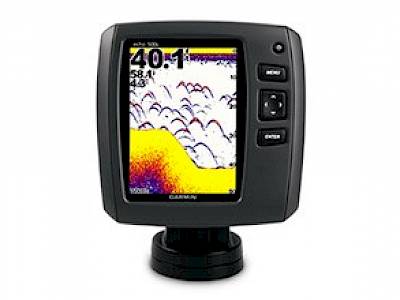

Boating Tech Talk Troubleshoot Intermittent Depth Readings?

Copyright © 2024 Pacific Yacht Systems.
Contact Us 604.284.5171
Shipping & Returns | Privacy Policy | Terms of Use | PYS Partners

Navigation : Echo sounder that looks into the future
Hauke Schmidt
· 07.10.2014
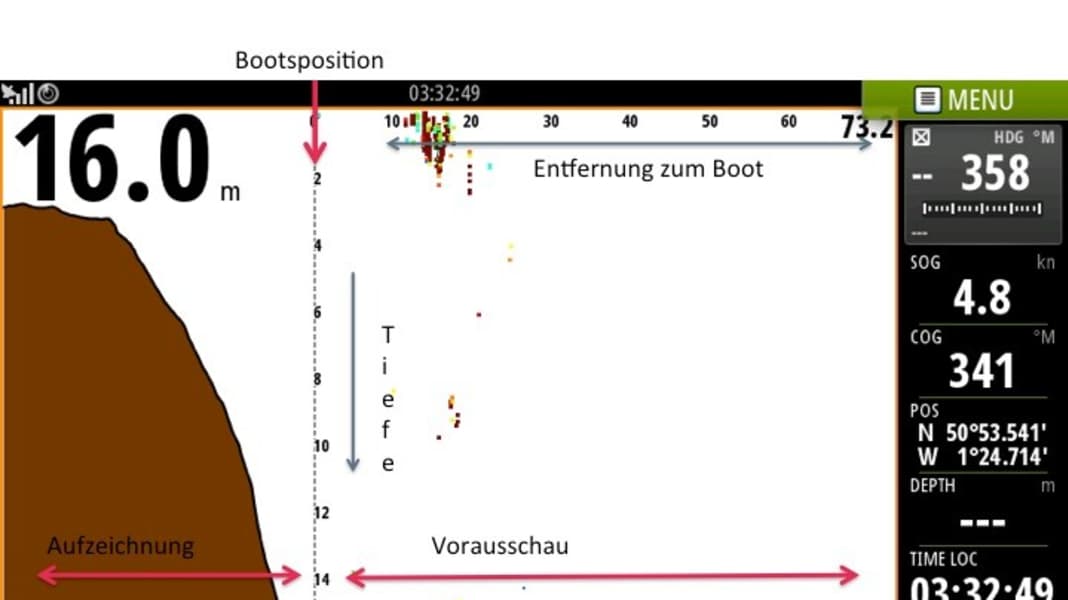
An echo sounder that shows the shallows before you run aground - what sailor wouldn't want that? A pioneer in this field is the British company Echopilot . With the Forward Scan, instrument manufacturer B&G, part of the Navico Group, is now launching a similar sonar system on the market. The echo sounder is designed to detect an area equivalent to eight times the water depth and thus offer real-time foresight.
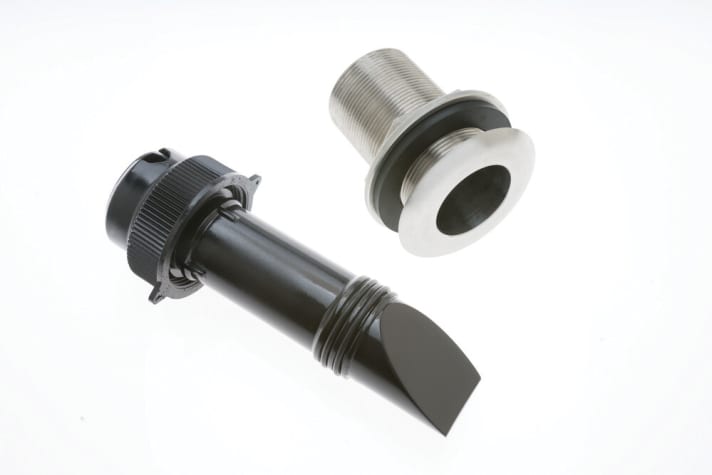
However, B&G equipment is required to operate the breakthrough transducer, which costs 237 euros, as the underwater world is displayed directly on a Zeus 2 series plotter, which must also be equipped with a sonar hub module. The complete system without plotter is available for 832 euros.
To make it easier to interpret the two-dimensional depth display, the system also shows a calculated soil culture in addition to the coloured echo intensity. In the so-called Hearing Line View, the information is also summarised as a multi-coloured advance line. If the water depth is too shallow, the section is coloured red.
To ensure that the sonar system is not disturbed by conventional echo sounders, the transducer operates at a frequency of 180 kilohertz. The ForwardScan images can be viewed and edited on a smartphone or tablet via the in-house GoFree Wi-Fi module.
Further information can be found at www.bandg.com .
Most read in category Equipment
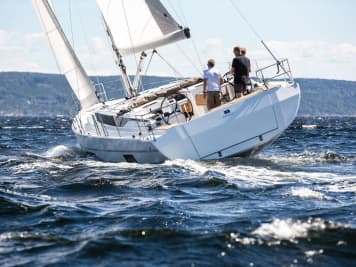
Echo sounder is an indispensable technical assistant for yachtsmen and fishermen, allowing you to accurately analyze the situation under the vessel . One of the most demanded questions among water motors, especially when choosing yachts for rent , is the fixing of the device sensor. Any echo sounder contains at least 2 components: a transducer and the device itself with a screen. Sensors come in different types depending on the installation. Correct (or incorrect) installation of the sensor will determine many points in the operation of the device.
Transom transducers are mounted near the outboard motor propeller and will severely distort the data when the boat enters planing mode. Among the disadvantages of this kind of sensors is a high probability of damaging the device while driving (debris, drifts, etc. can interfere)
Another type of sensors are those mounted on the bottom and located inside the hull (the mounting method is only suitable for ships with a plastic hull). The disadvantage of such sensors is that the signal loss due to the operation of the device through the body is significant, the sensitivity is reduced, and the scanning depth is small. Often, 1-4 kW sensors are mounted on the bottom, with an effective echo sounding depth of 250-3000 m.

Plunge-in inclined sensors, the emitter of which has a free stroke in the middle of the body at a given angle, are designed for mounting on keel bodies and have approximately the same power as the in-hole ones. For installation, a place is selected with the formation of turbulence in water flows - in front of the rudder, keel or propeller.
Most common sensors
Based on the experience of our specialists in yacht rental , transom sensors are most widely used, but, as already mentioned, This mounting method has many disadvantages. A sensor that receives data through the yacht's hull material does not work on ship hulls made of wood, aluminum or steel. And for installation, they select places where there are no air bubbles in fiberglass - they contribute to a delay in the conduction of sound. The good thing about in-hole sensors is that they are suitable for yachts of any size, and the propellers do not generate any significant interference for them. Tilt sensors compensate for bottom deadliness at the point of installation and ensure maximum efficiency of the device, but their cost often reaches 50% of the price of the echo sounder.
The most commonly used type of echo sounder is the cheap 1- and 2-beam instruments used by fishermen, travelers and even ice fishing aficionados.

Travelers buy fancy chartplotters , combining several devices at once: a navigator, an echo sounder and a remote control for tracking engine parameters. And fishermen and divers use expensive structured scanners capable of producing incredibly accurate color images of the bottom.
Interestingly, even the simplest echo sounder allows to record the temperature of the water overboard, notify of a sharp decrease in depth and inform about a decrease in voltage in the on-board network.
Installing the echo sounder
The echo sounder, if necessary, can be installed independently, while it must be remembered that the quality of the resulting image will directly depend on the correct installation of the emitter. When placing the remote sensor, it will be necessary to ensure reliable contact of the device with water. The perpendicularity of the sensor to the water surface must also be ensured. When installing a built-in sensor, it is better to entrust this work to experienced specialists with professional tools.
The method of gluing the sensor into the body is very convenient, but it cannot be used in some cases:
- When the yacht has a hull made of wood, there will be no signal due to the porosity of the wood structure;
- When the body contains transverse steps - due to air bubbles in the boundary medium, the aerated bottom is not suitable for mounting the meter;
- In the case of a whaleboat stern of a displacement hull, hovering on waves in the air and at this time the sensor's connection with the bottom is lost, etc.

After the cable is laid in accordance with the rules, and the monitor is fixed, the task is to find an acceptable place for the sensor to be located so that the quality of its readings does not suffer from air bubbles falling under the bottom on the move. It is possible to screw the transom to the transom from the inside , then it will be necessary to maintain a certain constant level of sub-bed water to prevent the formation of an air wedge between the bottom and the transducer.
As an option - glue the sensor on a straight section of the bottom between the redans, - it is fixed with construction sealant or auto-plasticine. You can also use the method when the gap between the bottom and the sensor is filled with a conductive liquid.
A correctly mounted sensor will delight the shipowner with stable readings throughout the season. By using an echo sounder, you significantly reduce the likelihood of running the boat aground or damaging the propeller . Enjoy sailing on your dream yacht!
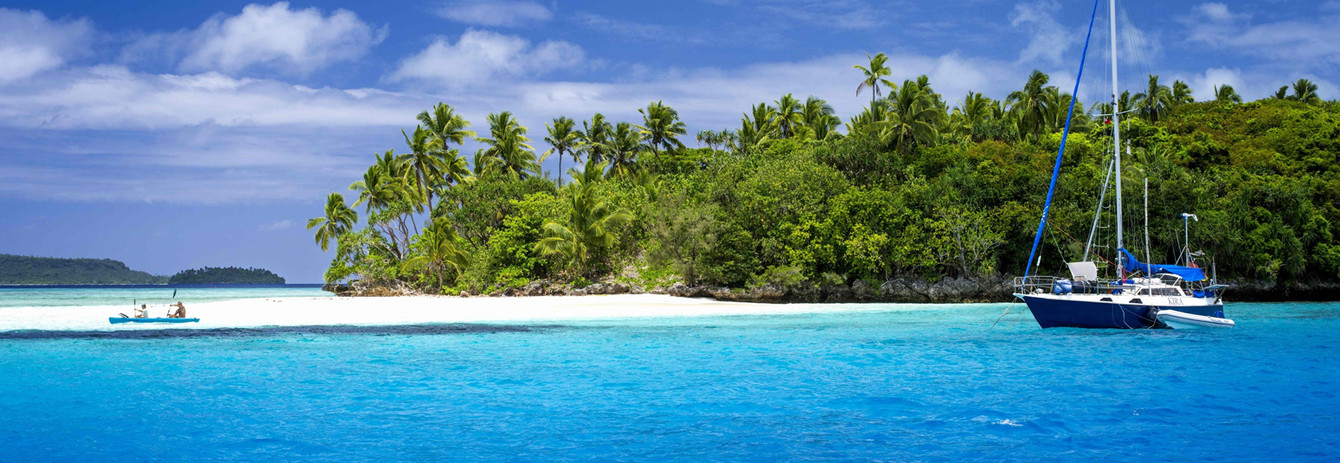
- Advertising
Customer reviews

- Netherlands
- United States
- United Kingdom
Cult of Sea
Maritime Knowledge base
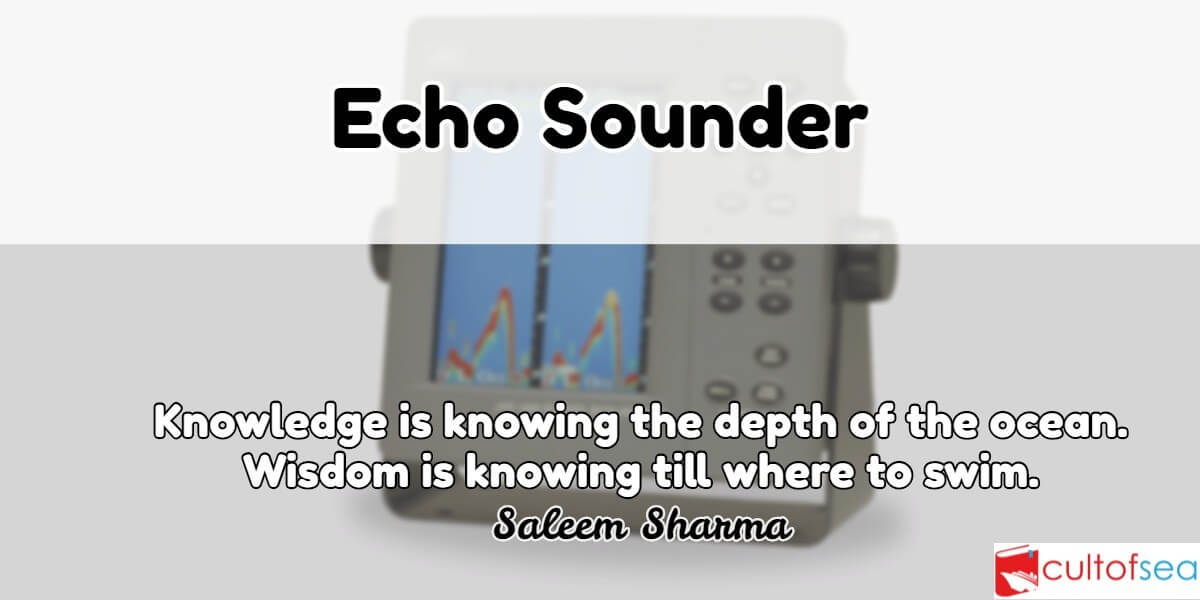
Echo Sounder – Principle, Working & Errors
One of the dangers faced by a ship is that of running aground. Usually, a vessel determines its position by means of GPS, Radar, Decca, Loran or visual bearings. The depth of water is checked from the echo sounder just as a matter of routine to see that the depth obtained matches with that show on the chart. However when the position is not accurately known while approaching the port, or crossing over a bar, or near the mouth of a river, or in a poorly surveyed area, the under-keel clearance and depth of water needs to be known. The echo sounder comes in handy in such situation.
An Echo Sounder is a type of SONAR (Sound Navigation And Ranging) device used to determine the depth of water by transmitting sound pulses into water
It works on the principle of transmitting sound waves from ship’s bottom and then measuring the time taken for the echo to be returned from sea. If the velocity of sound in water is known the time will be proportional to the distance travelled.
The time taken by the waves to travel to and from the seabed is measured and depth can be determined, by the formula Distance=Velocity x Time/2

Reason for using sound waves
For using the principle of ranging it is necessary to send some for energy signal and measure the time duration for its reflection to arrive. In case of echo sounder, the signal cannot be electromagnetic, as there is heavy attenuation in water. It cannot be light because water is not transparent and there is no mirror-like reflecting surface at the seabed. Sound propagation is by setting up vibrations in the medium. Water is virtually incompressible so if vibrations of very small magnitude are set up they can travel great distances.
Creation of sound waves
This can be done by two methods viz. magnetostriction and electrostriction.
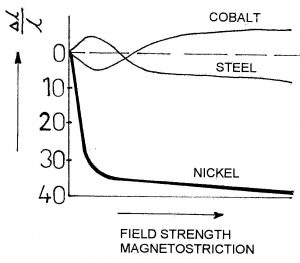
Magnetostriction
Ferromagnetic material such as iron, cobalt, nickel experience change in length when placed in a magnetic field. This occurs due to the rearranging of the domains or molecules within the material.
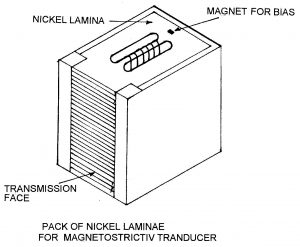
In case of iron and cobalt the change in length is expansion and then contraction but in case of nickel, it is the only contraction. Nickel is more commonly used, as its change per unit length is highest of all. The process is also reversible; meaning that if the length of such materials is changed it will create a magnetic field around itself. The change in length will take place even if the direction of the field is reversed. Therefore, if an alternating current is used to create the field then the frequency of nickel contraction will be double of that of the current. This handicap is overcome by using a permanent magnet to create a magnetic bias. The field created by the alternating current will either increase or decrease but it never changes direction. If bias field says 5 units and the current creates a field of 4 units then the results will vary between 1 and 9 units. Frequencies up to a few hundred kHz are therefore possible with magnetostriction.
Electrostriction
Crystals of certain materials like lead zirconate, lead titanate and barium titanate and quartz etc. experience potential between two faces when the crystal is stressed.
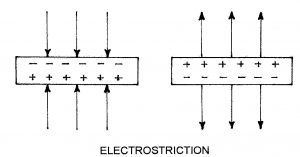
If a face gets a positive charge on compression, then it will get a negative charge if tensional force is applied. This property is also reversible i.e. if the potential is applied to two faces the crystal will experience tensional or compressive forces leading to change in dimension. For a given crystal the change in dimension is maximum along a particular axis. So while cutting a crystal care is to taken see that the faces selected will provide a maximum amplitude of vibration. The natural frequency of vibration will depend upon physical dimensions of the slice. For creating very high frequency a very thin slice is used. Frequencies up to 1 MHz are possible.
The acoustic pulses of very short duration are transmitted vertically at the rate of 5 to 600 pulses per minute having a beam width of 12 to 25°. These pulses strike the seabed and get reflected back towards the receiving transducer as echoes. These received echoes are converted into electrical signals by the receiving transducer and after passing through the different stages of the receiver, the current is supplied to the stylus which bums out the coating of the thin layer of aluminium powder and produces a black mark on the paper indicating the depth of the seabed.
Errors of the Echo Sounder
- The velocity of propagation in water The velocity of acoustic wave changes if temperature, salinity or pressure changes and since velocity is not correct, the depth recorded will be inaccurate.
- Stylus speed error: The stylus is rotating with a certain constant speed and the speed of the stylus that the time is taken for the stylus to travel from top to bottom is exactly equal to that for an acoustic pulse to travel twice the distance of the range selected. Due to the fluctuation in the voltage, the speed of the stylus motor changes hence the depth recorded Will be inaccurate. It should be checked periodically and adjusted as per the instruction is given in the manual.
- Multipath Echoes: The echo may be reflected a number of times between the keel and the seabed, thereby giving multiple depth marks on the record, in such case the first echo is the correct depth.
- Pythagoras error: This error is found when two transducers are used one for transmission and other for reception.
- Thermal and Density layer. The density of the water varies with temperature and salinity, which will tend to form different layers. It is possible for echoes to return from the surface of these layers and a faint line appears between zero and actual depth.
- Zero line adjustment error If the zero adjustment is not correct, the depth recorded will not be correct.
What are an Echo Graph and Echometer?

When the actuator magnet passes over the sensor, the sensor sends a signal to trigger unit. This activates transmitter after a time delay, which feeds high voltage signal to transducer for onward transmission of sound waves. The transmitter also sends a weak electrical impulse to stylus via the conducting rail. The stylus moves over a paper which is coated with electrically conductive material and which moves over a metal plate. The electrical impulse carried by stylus causes a layer of paper to be burned off making a mark on the paper. This mark coincides with the zero of graduation. The time delay is such that the mark on the paper is made to coincide with departure of sound wave from the transducer. When the echo returns the mechanical vibrations set up electrical signal, which is fed to the stylus. The stylus makes a second mark on the paper. The depth can be read from the graduation s on the paper or by help of a scale, which is next to the stylus. If echo were received after the stylus has gone past the paper area there would be no visible indication. In other words the movement of the stylus outside paper area will be unutilised. In order to put this to use more than one sensor is fitted. In the figure three sensors are shown. By selecting sensor No.2 the actuator will activate the transmitter before the stylus has reached the zero mark. The echo will be received while the stylus is on the paper. If at sensor No.1 the range is say 0-50 m. at sensor 2 it 50-100 and sensor 3 it is 100-150 m. Thus if the seabed is 75 m. from the keel the stylus will make a mark at halfway on the paper provided sensor 2 is in use. While using sensor s 2 or 3 there is no zero mark indication.
This method of increasing the range is called ‘phasing’ because the start of the pulse is not synchronised (not in phase) with the position of the stylus on zero line on the paper. Another way of increasing the range is by changing the speed of stylus. Suppose the speed of stylus is reduced to 1/4th then it will take four times the time to travel the length of the paper. With speed of sound remaining unchanged the paper will then represent a range of 0-200 (four times of 0-50), while on sensor 1, 200-400 on sensor 2 and 400-600 meters. on sensor 3.
The control switch, which changes the stylus speed, also changes the duration of pulse, pulse repetition rate (PRR) and the time delay for making the zero mark. Pulse will be longer, PRR will be smaller and time delay will be increased, as the stylus will take a longer time to reach the zero line. Echo meters usually use a combination of phasing as well as the change of stylus speed, to achieve a wide detection range and retain good resolution at short and medium ranges.
This gives an analogue or digital readout of the soundings.
- GPS (Global Positioning System)
- International Institutions and their Association…
- BLU Code - Code Of Practice For The Safe Loading And…
- Hatch Covers - Function, Inspection, Tests,…
- Ballast Water Management - Merchant Ships
- ISPS code - A measure to enhance the security of…
November 21, 2021 at 4:11 am
hi dear i want to know about testing of transducer in ducking
February 2, 2023 at 8:24 pm
I have a Ferrograph inshore echo sounder but without the 143kHz transducer. it is a valve/tube device working from the boats 24VDC supply. The display is the spinning type. i am going to need a transducer or make some kind of dummy load to test it but I have no details of impedance, power etc. would you have a schematic by any chance or a service manual. it seems to be 1964 to 1969 vintage Cheers Martin
September 23, 2023 at 7:33 pm
An echo sounder, also known as a sonar or depth sounder, uses sound wave reflection to determine the depth of water. This is how it works:
1. **Pulse Generation:** The echo sounder produces a brief burst of high-frequency sound waves, often in the ultrasonic range (above the human hearing range).
2. **Sound Wave Propagation:** These sound waves flow downward via the water.
3. **Reflection from the Seabed:** When sound waves collide with the seafloor or any underwater object, they are reflected back to the surface.
4. **Receiving the Echo:** The transducer (a specialized underwater microphone) on the echo sounder detects the returning sound waves.
5. **Time Interval Measurement:** The echo sounder measures the time it takes for the sound wave to travel.
4. Receiving the Echo: The transducer (a specialized underwater microphone) on the echo sounder detects the returning sound waves. 5. Time Interval Measurement:The echo sounder measures the time it takes for the sound wave to travel.
September 23, 2023 at 7:39 pm
Echo-sounder is primary acoustic equipment used for navigation and for fish finding purposes. ➢It works on the principle of sound wave propagation in water. amplifier of transmitter before it reach to transducer. concentrate the sound energy which is emitted as a beam.
Errors of the Echo Sounder The velocity of propagation in water The velocity of acoustic wave changes if temperature, salinity or pressure changes and since velocity is not correct, the depth recorded will be inaccurate.
September 23, 2023 at 7:44 pm
September 23, 2023 at 7:50 pm
The principal acoustic instrument used for navigation and fish discovery is the echo-sounder. It operates on the basis of sound wave propagation in water. The transmitter’s amplifier is used before it reaches the transducer. The sound energy that is emitted as a beam is concentrated.
Echo Sounder Mistakes The velocity of propagation in water The velocity of an acoustic wave changes as temperature, salinity, or pressure change, and because velocity is incorrect, the depth recorded is incorrect.
September 23, 2023 at 7:54 pm
Leave a Reply Cancel reply
Your email address will not be published. Required fields are marked *

- Search forums
- Yachting Monthly's Scuttlebutt
How deep can a yacht echo sounder sound.
- Thread starter Mandarin331
- Start date 21 Jun 2017
- 21 Jun 2017
Mandarin331
Just an idle discussion which we couldn't answer, maybe some of the transatlantic voyagers can answer this? The question is what is the maximum depth which a standard yacht (say raytheon) echo sounder can record and what is the reason for the limitation?
Well-known member
My NASA Clipper has a maximum of 99 metres.
capnsensible
Rarely more than 100 or 120 metres. Mostly lack the power for any deeper and will depend on nature of sea bed, sea state and how fast you are going. In my experience.
LittleSister
LittleSister said: Deep enough for most practical purposes except finding the Mariana Trench! What were you hoping to use it for? Click to expand...
Mandarin331 said: We were idling discussing venturing far far away from the Thames Estuary, where depths over 20m give us vertigo, Click to expand...
First sounding approaching Cape Verdes (hard basalt) with a Raymarine ST60+ was 186m.
Quiddle said: First sounding approaching Cape Verdes (hard basalt) with a Raymarine ST60+ was 186m. Click to expand...
My ancient (1980s) but lovely B&G Hecta loses contact with the bottom at around 180m. In anything shallower than that it is, judging by the charts, quite accurate.
All depth sounders will have different maximum depths at which they still work, depending on salinity of the water, thermal layers in the water, angle of heel of the boat and so on. My Raymarine sounder sometimes gives up at 110m and sometimes any figure up to 155m.
Porthandbuoy
I'd be interested to know how many of the previous posters' transducers are mounted in an oil filled tube shooting through an inch of solid grp. Mine is, and bottoms out at around 40m.
- 22 Jun 2017
Active member
183m is the maximum I've ever spotted, which I remember because it surprised me that I had a reading at that depth.
parsifal said: My NASA Clipper has a maximum of 99 metres. Click to expand...
My Garmin 4nnS GPSMAP allegedly does 200m, but I don't recall ever having seen anything like that anywhere that I have sailed.
My old ST60 was normally reliable to 100 metres, and the most I ever saw it read was 144 metres. On my present yacht I installed a 'cheap' NASA Clipper depth sounder, which has proved only reliable up to 35 metres, though it will occasionally manage more. This is adequate for most purposes, but for blue-water cruising, specially around atolls, being able to get reliable readings up to 50 metres proved a must. (Though maybe these days with charts accurately aligned to WGS84, it might not be quite so essential as formerly). Incidentally, both these I tested accurate up to 20 metres.
My Garmin fishfinder reads to 300m.
Mine reads down to about 100m. As long as I have more than 2m I am happy.
I remember sailing with an ancient sounder which went 'around the clock' at some modest depth and started reading 0.1 fathom. It was fine on the east coast, apparently, but invented several new shallows in the Channel. As well as displays losing the leading digit, sometimes the sounder itself receives the previous pulse instead of the current one. modern units should be cleverer that that...
AntarcticPilot
In the Clyde, my through hull mounted Raymarine ST60 depth sounder regularly lost the bottom between Ardlamont Point and Tarbert. The depth at which it stopped varied a bit, but around 120m. No yacht depth sounder will reach the bottom in even the outer part of the continental shelf, far less the deep oceans. The power requirement would be too high, as it goes up as the square of the depth. Assuming all else was unchanged, the ST60 would need 4 times the power to reach 240m, and 16 times the power to reach 500m, which would cover most of the continental shelves. 1000m would require 64 times the power, 2000m 256 times and so on. You could improve on those figures by having a transmitting array that gave a narrower beam, but it would be prohibitively big for most of our boats.
Other threads that may be of interest
- East Coast Forum
Members online
- SwedishLass
- RunAgroundHard
- Petertheking1982
- WindermereColvic
- simonfraser
- suffolklass
- Hairy Hobbit
- Fr J Hackett
- Charlie Boy
- Slipstream 34
- Portland Billy
- Andrew_Fitton
- Baggywrinkle
- kindredspirit
- Cymrogwyllt
- GunfleetSand
- chriscallender
- Chiara’s slave
- jointventureII
Share this page
- Apply for Vendor
- Vendors List
- Delivery & Payments

Marine Echo Sounders for Sale
Sale of marine echo sounders for yachts/boats.
On this page, you will find a catalog of echo sounders with the best prices on the market. All products come with the manufacturer's quality guarantee.
What is an Echo Sounder?
Echo sounder is a specialized sonar, a measuring device that is used to study the structure and topography of the bottom, as well as living and non-living objects located in the water column or on the bottom.
Monitoring the water column in echo sounder is done using:
- ultrasonic transmitter (emitter);
- receiver (sensor);
- a computer for processing the received data and drawing a topographic map of the bottom;
- screen (display).
Processed echo sounder data is conveniently displayed on the screen of modern devices. There is a wide selection of devices of various price categories: from the simplest models to multifunctional chartplotters-echo sounders with a widescreen touch screen.
topRik marketplace presents innovative echo models sounders of the latest generation from the best manufacturers of marine equipment: companies like Garmin, Raymarine, Lowrance, Furuno, Simrad, etc.
What Are Echo Sounders Used For?
Echo Sounder is a fish-finding equipment and an indispensable companion not only for fishing enthusiasts, but also for yachtsmen, as well as those going out to sea in a sailing regatta. This equipment also helps those who are interested in spearfishing, exploring the seabed (in particular in the area of coral islands), searching for sunken objects, etc.
Operating Principle of Echo Sounders
The electrical impulse generated in the control unit is transmitted to the echo sensor sounder. Converted into an ultrasonic wave, it follows through the water to the bottom, reflected from it, and passes back. The wave is then processed by the control unit. The device shows not only the state of the bottom topography, but also objects encountered along the way: stones, algae, river or sea inhabitants. Modern echo models sounders can recognize even small objects, for example, small fish moving in a school.
Echo sounder sends continuous sequential signals, while the image on the screen is constantly adjusted. One of the important factors in the operation of echo sounders is the processor power, the device must not only quickly read and process information, but also produce it on the screen in an understandable and readable form.
At high vessel speeds, outdated echo sounder models may experience delays, not reflecting current information and a fully loaded map.
Improved echo sounders presented in this section of the topRik marketplace are equipped with premium processors that work without delays and, even more so, stops, in real time.
Additional Functions of an Echo Sounder
In addition to monitoring functions, echo sounders can be used for navigation purposes. Chartplotters-echo sounders with built-in high-sensitivity GPS allow you to save navigation data and electronic maps. This function will allow you to save successful fishing spots in the echo sounder and make it possible to accurately return to your favorite location. Data exchange with other devices expands the fish-finding capabilities of the echo sounder. Materials received on one of the gadgets are automatically synchronized with other devices. When you choose a widescreen chartplotter/fish finder, you can fully enjoy high-quality images and a variety of information obtained by connecting with other compatible marine equipment.
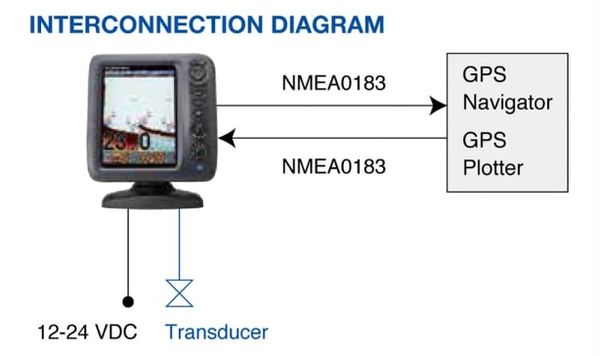
Types of Echo Sounders
Echo sounders have different purposes, but the principle of operation is the same for all. Sound pulses of the device shine through the water column, reaching the bottom. As they return, they draw an echo on the display sounder corresponding picture. So echo sounder records all reflected and re-reflected waves, displaying the received information in an easy-to-read form.
Conditionally echo sounders can be divided into several categories, in each of which these devices have their own application features. Strictly splitting echo sounders into single categories is quite difficult, because most of them will end up in several categories at once, having a fairly wide range of capabilities. Among the main types of echo sounders sailors highlight the following:
- navigation;
- sonars and sonars;
- fish-finding;
- echo modules sounders for chartplotters and MFDs.
Forward Looking Echo Sounders
Forward looking echo sounders are designed to provide advance information about the bottom topography. In other words, echo sounder in the classical sense, namely a vertical scanning device that displays the space located exclusively under the bottom of the vessel, cannot warn of shoals or other obstacles in the path of the yacht, so it became necessary to use the so-called horizontal scanning with a wide beam in order to have information about underwater objects such as along the course of the ship, both to the right and to the left of it.
Most such echo sounders use several beams of different frequency ranges in their work to most fully display the underwater situation.
Navigation Echo Sounders
Navigation echo sounders can also be forward-looking; their peculiarity, rather, is that they are not designed to search for fish, but are part of navigation safety systems and are capable of transmitting information not only to the display for visual control, but also to special shipboard devices, the use of which is regulated by supervisory authorities, for example, to an ECDIS or a voyage data recorder (VDR). Information received from navigation echo sounder, is stored in memory and can be played and analyzed if necessary.
Sonars are the main part of echo sounder – a device that directly sends and receives sound impulses. Typically, active sonars are used, that is, sonars that generate sound pulses that then return to the sensor in the form of an echo. But there are also passive sonars used to find marine objects that produce their own noise.
Fish Finder Echo Sounder
Fish finding echo sounders are the most common category of this equipment among not only professionals, but also amateurs. As the name suggests, their main purpose is to search for fish. At the same time, a good fish-finding echo sounder includes a sonar, and can simultaneously be both navigation and forward-looking.
Echo Sounder Module for MFD
Echo sounder modules for chartplotters and multifunctional marine displays are intended for professional use and require serious marine equipment, without which they don’t make much sense.
The module is executed as a special block that does not have any visualization tools. Its purpose is solely to collect information and subsequent transmission to the on-board network. Depending on the equipment used on board, a compatible echo sounder module is used, which is integrated into the on-board network. Information from the echo sounder module is visualized directly on the on-board displays. Such devices, as a rule, are of the highest quality and have a wide range of capabilities that fully complement the functionality of on-board electronics.
Differences in the Rays Numbers
The more rays the echo sounder creates, the larger the area that can be scanned with it and the more detailed the information displayed is. The beams differ in coverage angle and frequency, forming different combinations.
An echo sounder usually has two beams. The first (narrow) ensures accurate drawing of objects under the bottom, and the second (wide) is necessary for better coverage. Echo sounders that create six beams can display 3D images that convey in detail the structure and topography of the bottom, as well as the shape and size of objects under water.
How to Choose a Sonar for Yachts or Boats
There are many different echo sounders and chart plotters, so deciding which one is right for you, your boat and the type of fishing you're doing isn't always easy. Here we've laid out a few basic principles to make it easier for you to understand what to pay attention to and why.
Display Size and Type
Echo sounders are available in screen sizes from 5 to 16 inches. Models are available with multi-touch, touch screen or keyboard controlled. Touchscreen models provide full control via the screen, keyboard, or both.
Display size
A large screen is not always a good thing, as one of the main considerations for placement on a boat is the available mounting space. Larger screens have better pictures, but first make sure they fit your boat.
Display type
Screens with premium IPS technology provide wide viewing angles as well as excellent clarity. Most displays feature non-IPS screens, but also high resolution ones with excellent clarity and color reproduction.
Just like in a computer, a faster processor ensures smoother operation. With echo sounders it means: fast menu operation, fast sonar data updates, as well as fast map drawing. All these factors make your boat trip more enjoyable.
With devices from a single manufacturer, setup is simple: the powerful sonar is ready to go right out of the box. Simply install the system on your boat and hit the water, or expand your system by selecting additional devices from a wide range of accessories.
Compatibility
Check the compatibility of the device you are purchasing. Most modern echo sounders provide compatibility with a wide range of marine equipment that will enhance your system, from trolling motors and shallow water anchors to third-party mapping and entertainment options.
Cartography
To get the most out of your display, you can use a card from one of the manufacturers. Whether on a lake or at sea, they are essential for locating and finding suitable fishing spots and getting there safely.
Additionally, there are many map features that you should pay attention to to make navigation and fishing easier. For example, depth shading will help you easily identify key fishing spots.
You can quickly identify places where fish like to hide. For example, ditches, cliffs, flooded roads. Spend less time searching for fishing spots and more time fishing. If you find yourself in unexplored areas, use the Genesis Live mapping feature in real time, available on most chartplotters, to create your own maps with contour accuracy down to half a meter.
Price of Echo Sounders
The last important point when choosing an echo sounder will be the cost of the device. On the topRik marketplace website you can find offers from all major manufacturers, compare characteristics, prices and equipment, get a free consultation from topRik experts on the details of the design and operation of the devices that interest you, and as a result, choose the optimal modelfor your yacht or boat.
So, let's summarize all of the above.
When choosing sonars (marine echo sounders) for boats and vessels, it is important to pay attention to several key aspects.
Sonar Type : There are two main types of sonars - single-beam and multi-beam. Single-beam sonars are suitable for basic tasks, while multi-beam sonars provide more detailed data about the waterbed.
Frequency : Sonars operate at different frequencies, and each frequency is suitable for specific types of water bodies. Higher frequencies provide more detailed images but have limited depth penetration, while lower frequencies allow detection of objects at greater depths.
Power : The power of the sonar affects its ability to detect objects and the bottom at greater depths. Choose a sonar with appropriate power based on the depth of the water body where you plan to use it.
Display and Resolution : Display quality and resolution play an important role in presenting the sonar data. Choose a model with a good display quality and high resolution to see details clearly.
Functionality : Check the provided features by the sonar. Some models may have functions such as displaying the seabed structure, fish detection, saving coordinates and routes, and other useful options.
Compatibility : Make sure that the chosen sonar is compatible with your navigation and fish-finding systems, if you have any.
Installation and Dimensions : Consider how the sonar will be installed on your boat. Ensure that the device's dimensions fit the available installation space.
Durability and Waterproofness : Considering maritime conditions, it is important to choose a sonar with a good degree of waterproofness and reliable construction.
Budget : Determine your budget in advance and choose a sonar within that range. Remember that quality equipment can impact navigation and fishing results.
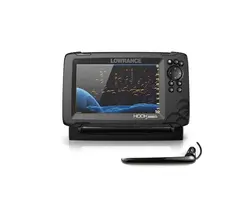
- Marine Radios
- Chartplotters
- Chartplotters Accessories
- Echo Sounders
- Wind Indication & Clinometers
- Transducers & Accessories
- Radar Units
- Handheld GPS
- Network Devices & Accesories
- Radios & Multimedia
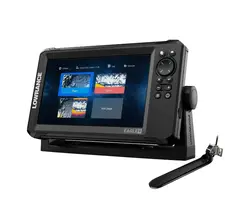
- Profile details
- Comparison list
- Gift certificates
- Terms of Use
- Privacy Policy
- Refund Policy
- Tallinn, Valukoja 8/2 (Regus Offices)
- +37253060890
- Mon-Sun 10.00 - 18.00
- [email protected]
- View on map
- Leave feedback

- CEESCOPE Single Beam Echo Sounder with GPS
- CEE ECHO Single Beam Echo Sounder
- CEE-LINE Echo Sounder
- CEE JET Personal Watercraft
- CEESCOPE-USV
- CEETIDE MAX Precision Radar Tide Gauge
- Hydromagic Training Videos
- HYPACK Training Videos
- Knowledge Base
- Case Histories
- Hydromagic Tutorial Videos
- HYPACK Setup Video
- Hydromagic Setup Video
- Support Request
- Request a Quote

CEE HydroSystems are a manufacturer of high quality hydrographic survey single beam echo sounders, with a focus on shallow water surveying from small boats or personal watercraft. CEE HydroSystems offer products aimed to streamline the survey process and offer the simplest, easiest, and fastest way to get the job done.
By selecting only the highest performing, top quality modern electronics components, CEE HydroSystems’ echo sounders lead the industry in specifications achievable in a compact and portable package.
With offices in Sydney, Australia and San Diego, USA contact us to discuss your survey requirements. We are ready to help with echo sounder solutions for your river, lake, pond, reservoir, estuary, surf-zone, or coastal ocean bathymetry survey challenges.
CEE-LINE™
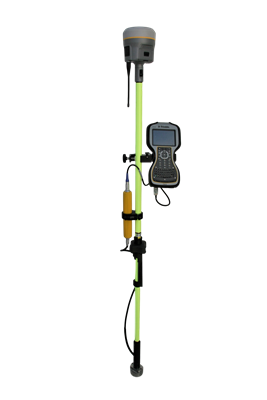
CEE-JET™ Surveying with University of Florida
For shallow water hydrographic surveys off the Florida, USA coast, researchers outfitted their SeaDoo watercraft with the latest CEE-JET™ single beam survey system. Using not much more than a screwdriver, the vehicle can be turned into a survey platform with CEE HydroSystems' add-on kit. The precise RTK GNSS, SBG Systems Ellipse motion sensor and 20Kt capable 200kHz CEESCOPE™ echo sounder data are all managed over WiFi. LEARN MORE HERE
A large US mine tailings pond was surveyed using the robotic CEE-USV™. The survey was a great example of a typical process for surveying in the mine waste environment. The outline of the water pool was unknown, so the USV was first used to determine the boundary for the survey. Then, the autopilot was used for a consistent and efficient survey. To learn more READ MORE HERE.
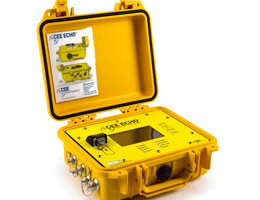
CEESCOPE™ Surveying at Davis Antarctic Base
Australian surveyors were in action on a shallow water survey at the country’s Davis Station Antarctic base, using a CEESCOPE™ “all in one” single beam echo sounder and CEE-TSF™ enhanced side scan. In the frigid temperatures of the coldest place on earth, the reliability and simplicity of operation afforded by the CEE package contributed to a successful outcome of the survey. Learn more about the expedition HERE .
An ideal application for unmanned surveying is industrial water where launching a manned boat is often undesirable. At three power station fly ash ponds in the Southwestern USA, the CEE-USV™ offered the solution for fast and safe surveys. Using the robotic CEE-PILOT™ autopilot ensured spectacular survey lines. READ THE CASE HISTORY HERE .
HYDROGRAPHIC SOFTWARE

CEE USV – Ultimate Reliability Test
Shallow Water Bathymetry
CEE USV – Action in Alaska
Sign up now for our WhatsApp newsletter and receive a FREE set of SVB playing cards!
Get the latest SVB news via WhatsApp!
- Product Selection Tool
- SVB@Youtube
- My SVB Account 0
- Compare list
Are you missing items that you have already placed in your shopping cart? Log in to see your saved items.
- Electronics, GPS, Navigation
- Instrument Systems
- Depth Sounders
- Depth Sounder Instruments

NASA MARINE CRUISER Echo-Sounder (Instrument / Sensor)

- View and order accessories
SVB recommends the following for this item

Product details
The NASA Cruiser Echosounder Marine Instrument can easily be read from a distance thanks to its large-number display of the measured depth. The depth sensor measures the current water depth in a range from 0.8 to 100 meters. The blue background lighting, ease of use, functionality and low power consumption of 10 mA (30 mA with lighting switched on) make the instrument a reliable stand-alone display. Delivery includes 7 meter connection cable and sensor. The outer dimensions of the display are 132 x 98 x 29 mm.
Accessories

What other SVB customers have to say
17 customer reviews.

Rate product
Customers also bought.

Similar items

Customers ask customers
Ask other SVB customers who have already purchased this product from us about their experience.
Your question will be automatically forwarded to other SVB customers and published on the product page. Please do not ask any questions which can only be answered by the SVB team – such as the status of an order or product availability. You are also more than welcome to contact our SVB team by email at: [email protected] or by phone on: +49 (0)421 57290510 .
- More "Customers ask customers" available in the following languages :

Echo Sounder
Marine solutions.
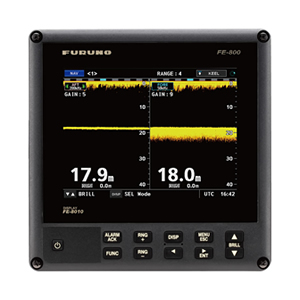
NAVIGATIONAL ECHO SOUNDER Model FE-800
FURUNO Navigational Echo Sounder FE-800 displays the clearance below the ship in the dual frequency operation
- Yekaterinburg
- Novosibirsk
- Vladivostok

- Tours to Russia
- Practicalities
- Russia in Lists
Rusmania • Deep into Russia
History of Kursk
11th century, first mention.
Although archaeological evidence suggests that there was a large settlement in the location of Kursk before the 8th Century, Kursk was first mentioned in 1032 in the Hagiography of St Theodosius (Feodosi) of the Kiev-Caves, who grew up in Kursk which was by then already a large, developed and important city. In approximately 1095 Izyaslav Vladimirovich, a son of Vladimir Monomakh, became the first prince of Kursk although he only ruled there for a year as shortly afterwards he was elevated to prince of Murom. However Prince Izyalslav had enough time to build a fortress in Kursk, making the settlement one of the strongest on the borders of Kievan Rus.
12th Century
Princes of kursk.
As only a minor principality, the Kursk Principality did not always have its own prince and never had its own dynasty of Ryurikid princes. The principality often passed between the various factions of Ryurikid princes during this period of time when internecine wars were common. In 1127 Vsevolod Olgovich took Chernigov from his uncle. To stop Mstislav the Great interfering in this conflict Vsevolod gave him Kursk and the surrounding lands. In turn Mstislav the Great made his son Izyaslav prince of Kursk. Izyaslav Mstislavich ruled as prince of Kursk until 1130 when he became prince of Polotsk. The Olgovichy princes were able to regain Kursk in 1136 : Gleb Olgovich ruled Kursk up to his death in the city in 1138 and was followed by his younger brother Svyatoslav Olgovich who ruled in Kursk until 1139 when he returned to be prince of Novgorod. In 1146 Svyatoslav Olgovich became prince of Novgorod-Seversky, which included Kursk. Svyatoslav gave Kursk to Ivan Yurievich, son of his ally Yuri Dolgoruky. Ivan Yurievich died in 1147 and Svyatoslav gave the principality to Ivan's younger brother Gleb who ruled in Kursk until 1148 .
Tale of Prince Igor's Campaign

In 1161 Kursk once again had its own prince - Oleg Svyatoslavich, son of Svyatoslav Olgovich. Oleg ruled in Kursk until 1164 when he became prince of Novgorod-Seversky. Oleg's brother Vsevolod succeeded him in Kursk. Vsevolod Svyatoslavich was known as Vsevolod Bui-Tur, meaning something along the lines of Mighty Bull. As his sobriquet suggests he was known for his bravery in dealing with the Cumans (Polovtsians). In 1185 Prince Igor of Novgorod-Seversky led an unsuccessful campaign against the Cumans which is the subject of the famous 12th-century Tale of Prince Igor's Campaign. Prince Vsevolod Bui-Tur accompanied his brother on the campaign and also features as one of the heroes in the tale. Vsevolod Bui-Tur remained prince of Kursk until his death in 1196 .
13th Century
Mongol-tatar invasion of rus.
After Vsevolod Bui-Tur's death in 1196 , it is unclear who became prince of Kiev. It is possible that he was succeeded by his nephew Prince Svyatoslav Olgovich of Rylsk. In 1223 a Prince Oleg of Kursk participated in the Battle of River Kalka against the Mongols, Prince Oleg was a descendent of Prince Oleg Svyatoslavich of Novgorod-Seversky, possibly the son of Prince Svyatoslav Olgovich of Rylsk. After Prince Oleg, information on the princes of Kursk is unclear. In any case the principality came to an end in 1238 when Kursk was destroyed during the Mongol-Tatar Invasion of Rus. Later Kursk was once again devastated by Mongol-Tatar forces in response to the citizens of Kursk rising up against the Mongol representative there.
14th and 15th Centuries
The Mongol-Tatar Invasion significantly weakened Russian territories and Grand Duke Algirdas of Lithuania took advantage of this situation. In the 1350s Algirdas managed to capture the Chernigov and Novgorod-Seversky lands, including Kursk, and incorporated them into the Grand Duchy of Lithuania. Kursk would remain part of Lithuania up until the beginning of the 16th century. In 1402 Kursk is mentioned as a Lithuanian city in an agreement between Lithuania and the Teutonic Order. Throughout the 15th century the city was raided by Crimean Tatars and the Nogais.
16th Century
Russian-lithuanian wars.
The Russian-Lithuanian War of 1500 - 1503 was very successful for Russia which gained control of one-third of Lithuanian territory, including Kursk. After the Russian-Lithuanian War of 1507 - 1508 a peace treaty was signed between Russia and Lithuania under which Grand Duke Sigismund I the Old of Lithuania recognised the territory won by Grand Prince Ivan III of Rus during the 1500 - 1503 war as territory of Russia. In 1597 Tsar Fyodor I had a new fortress constructed in Kursk to protect it from Crimean Tatar raids.
17th Century
Znamensky monastery.

Kursk was one of the first cities to declare its support of the First False Dmitri in 1604 . When Dmitri was in Kursk he demanded the Our Lady of the Kursk Root Icon be brought to him and later he took it with him to Moscow. In 1612 Polish interventionists began besieging the Kursk fortress. The defenders refused to surrender even though the situation looked hopeless. Legend has it they made an oath to build a monastery should the Virgin Mary protect them. Several weeks later the siege was lifted and the fortress did not fall. The defenders immediately began to fulfil their oath and built a wooden church dedicated to the Nativity of the Virgin Mary. In approximately 1615 , Tsar Michael returned the Our Lady of the Kursk Root Icon to the nearby Korennaya Hermitage and in 1618 the icon was transferred to a newly established monastery in Kursk. It remained in Kursk thereafter only returning to the Korennaya Hermitage on annual religious processions. In 1649 on the orders of Tsar Michael a new stone cathedral was built especially to house the icon and from this point onwards the monastery became known as the Znamensky monastery.
18th Century
Administrative reform.

In 1708 Kursk became part of the Kiev Governorate and in 1727 part of the Belgorod Governorate. In 1779 it was elevated to the administrative centre of the Kursk Viceroyalty. A coat of arms was officially approved for the city in 1780 which depicts three partridges flying on a blue strip on a silver background. In 1781 there was a major fire in Kursk and subsequently a new general plan was adopted for the city. Kursk became the administrative centre of the in 1797 .
19th Century
Our lady of the kursk root icon and religious processions.

In the mid-19th century the religious procession with the Our Lady of the Kursk Root Icon from Kursk's Znamensky Monastery to the nearby Korennaya Hermitage became one of the biggest religious events in the empire and tens of thousands of people took part in it. In 1883 the artist Ilya Repin depicted this religious procession in his famous painting in which he shows the various social strata in Russia at the time. In 1898 an anarchist placed a bomb in the Our Lady of the Sign Cathedral of the Znamensky Monastery under the Our Lady of the Kursk Root Icon. The explosion caused great damage to the cathedral but when the priest found the silver case of the icon in the rubble, he discovered that the icon itself has miraculously survived.
20th Century

In 1917 Soviet power was declared in Kursk, but the volunteer army of General Anton Denikin briefly occupied the city from September to November 1919 when the Soviets retook the city. When Denikin's army left Kursk they took with them the Our Lady of the Kursk Root Icon, which was eventually taken to the USA where it remains today. In 1934 Kursk became the centre of the newly-established Kursk Region.
Second World War

On 29 August 1941 Kursk experienced its first bombing raid by the Luftwaffe and on 1 November 1941 the city was attacked. Kursk fell two days later on 3 November 1941 and was only liberated on 8 February 1943 by the 60th army of the Voronezh Front. The liberation of Kursk resulted in what is known as the Kursk Salient - a Soviet-controlled bulge on the frontline around the city. It was obvious to the Soviets that soon Hitler would launch an attempt to recapture the city. Marshal Zhukhov was among those who argued that the Red Army should go on the defensive and only once the Nazis had been exhausted should they launch a counter-attack. This proved to be a successful tactic and at the Battle of the Kursk Salient, which was fought between 5 July to 23 August 1943 , the Soviets were victorious, although at a very high cost. The Battle of Prokhorovka (often also called the Battle of Kursk) took place during the Battle of the Kursk Salient in Prokhorovka outside Belgorod and was the largest tank battle in history. After the Battle of the Kursk Salient, the Nazis remained on the defensive for the rest of the war.
21st Century

After the fall of the Soviet Union, many of Kursk's churches were once again reopened. This included the Znamensky Monastery and the new century saw the religious procession from the monastery to the Korennaya Hermitage being revived and gaining in popularity. In 2007 Kursk was awarded the title of City of Military Glory for the “courage, endurance and mass heroism, demostrated by defenders of the city in the struggle for the freedom and independence of the Motherland”.
Plan your next trip to Russia
Ready-to-book tours.
Your holiday in Russia starts here. Choose and book your tour to Russia.
REQUEST A CUSTOMISED TRIP
Looking for something unique? Create the trip of your dreams with the help of our experts.

IMAGES
VIDEO
COMMENTS
So how can sonar help on a yacht when we have already have GPS, echo sounders and chart plotters?
Sonar and forward-looking depth sounders are often seen as the preserve of those whose primary interest is fishing. However, a huge amount of effort has been invested in these products over the ...
Would you like to be able to spot an obstacle before your boat hits it? Of course you would, and so would every other sailor in the world. Looking ahead is the Achilles' heel of the conventional echo sounder, which can only tell you the depth of the water in which you are already floating. If you wait until the sounder reads zero, it's too late. That's where forward-looking sonar comes in.
EchoPilot is proud to be featured in the annual SuperYacht Technology Summer Blueprint. The annual Blueprint is selected for only the best technologies for the SuperYacht Market and is featured worldwide. EchoPilot has specialized in Forward Looking Sonar since the 1940's and offers a variety of Forward Looking Sonar systems.
Garmin GNX 20. Best depth sounder for customisation. The easy-to-read GNX 20 marine instrument display from Garmin displays black digits on a white background, or background in a variety of colours. It is able to display depth, speed, wind and 50-plus marine and boat parameters.
To get accurate information, an echo sounder is used by officers on watch. It measures the depth of water and more importantly, the under-keel clearance. The echo sounder transmits sounds from the bottom of the ship to the sea bed. The main components are the transmitter, transducer, receiver, and display unit.
Understanding Echo Sounders. By Dag Pike. Echo sounders that provide depth information were at the forefront of modern electronics. Echo sounders were one of the original electronic systems, developed some 60 years ago. I remember those early units with a grey box sitting on the dash with the indicator whirring round and round.
This high resolution echo allows the fishfinder to detect smaller targets, like fish, with less background noise but at a reduced depth. Sonar is a general term that covers all underwater sound imaging technologies, including both depth sounders and fishfinders.
An echo sounder that shows the shallows before you run aground - what sailor wouldn't want that? A pioneer in this field is the British company Echopilot. With the Forward Scan, instrument manufacturer B&G, part of the Navico Group, is now launching a similar sonar system on the market. The echo sounder is designed to detect an area equivalent to eight times the water depth and thus offer real ...
Installing the echo sounder sensor on the yacht. Echo sounder is an indispensable technical assistant for yachtsmen and fishermen, allowing you to accurately analyze the situation under the vessel ...
The ECHOTEST II is a simple to use hand-held sounder, especially for mobile applications, such as diving, cruising in an inflatable boat or canoe. The ECHOTEST II displays the water depth or the distance to the shore side or to rock or a bulkhead.
Raymarine B258 Bronze Dual Freq Transducer - E66082. RRP Inc VAT: £1,015.00. Our Price: £875.00. Ex VAT: £729.17. he transducer is the heart of a sonar / fishfinder system. The device converts electrical pulses into acoustic energy or sound waves and transmits these waves into the water. When the transducer receives the reflections (echoes ...
Installing the echo sounder sensor on the yacht Echo sounder is an indispensable technical assistant for yachtsmen and fishermen, allowing you to accurately analyze the situation under the vessel. One of the most demanded questions among water motors, especially when choosing yachts for rent, is the fixing of the device sensor.
Echo Sounder - Principle, Working & Errors One of the dangers faced by a ship is that of running aground. Usually, a vessel determines its position by means of GPS, Radar, Decca, Loran or visual bearings. The depth of water is checked from the echo sounder just as a matter of routine to see that the depth obtained matches with that show on the chart. However when the position is not ...
Just an idle discussion which we couldn't answer, maybe some of the transatlantic voyagers can answer this? The question is what is the maximum depth which a standard yacht (say raytheon) echo sounder can record and what is the reason for the limitation?
Catalog with prices for new marine Echo Sounders for yachts from the best vendors in the world. Specification, reviews and delivery conditions.
Innovative Echo Sounders for Shallow Water Hydrographic Survey Bathymetry CEE HydroSystems are a manufacturer of high quality hydrographic survey single beam echo sounders, with a focus on shallow water surveying from small boats or personal watercraft. CEE HydroSystems offer products aimed to streamline the survey process and offer the simplest, easiest, and fastest way to get the job done.
Echo-sounder with a large display and blue backlight. The unit displays the water depth from 0.8 m to 100 m and is equipped with a shallow and deep water alarm.
FURUNO Navigational Echo Sounder FE-800 displays the clearance below the ship in the dual frequency operation. Merchant Marine.
Details: Honcharenko said that these drones are equipped with a multibeam echo sounder designed to survey the bottom topography for situational awareness of the underwater space. Quote from Honcharenko: "The main task of a multibeam echo sounder is to collect accurate data about the seabed and marine environment.
First Mention. Although archaeological evidence suggests that there was a large settlement in the location of Kursk before the 8th Century, Kursk was first mentioned in 1032 in the Hagiography of St Theodosius (Feodosi) of the Kiev-Caves, who grew up in Kursk which was by then already a large, developed and important city.
6 August. On 6 August 2024, Russia reportedly deployed air and artillery forces to counter a Ukrainian border incursion in Kursk Oblast. Ukrainian fighters, equipped with tanks and armored vehicles, crossed into Russian territory. The Russian Ministry of Defense responded by sending troops and aviation units to the area.
Ukrainian troops have advanced up to 30km inside Russia, in what has become the deepest and most significant incursion since Moscow began its full-scale invasion of Ukraine in February 2022.